#let's give non-western cinema more attention!
Text
Hey film enthusiasts, especially those who’d like to see more non-western movies! And hello language lovers and those learning kurdish/interested in kurdish, i have very exciting news for all of us! Today (16.04.21) is the start of the global kurdish film festival, all online and - now get this - for free!!! To take part, you only need to create a free account on https://www.globalkurdishfilmfestival.com/ (it took me 10 sec to sign up) and you get access to 106 kurdish movies and documentaries, produces by kurdish directors, ranging from 1959 to 2021 and categorized into themes. I’m very excited and hope that other people appreciate this opportunity as much as i do!
#would appreciate it a lot if you could boost this maybe :)#let's give non-western cinema more attention!#i'm like agfgdfdaafdhgfad SO excited omg. they have films i've been meaning to watch#they have old classics by the legendary kurdish director yilmaz güney! and newer releases by talented kurdish directors#i wish i could watch all of them until th 28th when the festival ends :( but i'll make sure to watch as many as possible!!#kurdish#kurd#kurdi#cinema#kurdish cinema#langblr#languages
31 notes
·
View notes
Photo

Why is this Ongoing American “Revolution” Bound to Fail?
Observed from outer space, the United States is in a revolutionary turmoil. Fires are burning, thousands of people are confronting police and other security forces. There are barricades, banners, posters, and there is rage.
Rage is well justified. Grievances run deep, through the veins of a confused and socially insecure population, in both cities and the countryside. Minorities feel and actually are oppressed. Indeed they have been disgracefully oppressed, since the birth of the country, over two centuries ago (see my latest report carried by this magazine).
There are some correct words uttered and written; many appropriate sentiments are expressed.
And yet, and yet… It looks like a revolution, it feels like a revolution, but it is not a revolution. It definitely is not! Why?
***
An expert on Communist China, a man who spent many years living and writing books about the most populous country on Earth, Jeff Brown, recently voiced something that immediately caught my attention. He described, accurately, on his China Rising Radio Sinoland, what has been taking place in his native country, United States:
“Protests in the USA, land of Marlboro Man will come to nothing because there is no solidarity, no vision, nor guiding ideology to unite the people in the common struggle against the 1%. Just ask the Black Panthers and Mao Zedong.”
This is precisely when ‘guiding ideology’ is desperately needed! But it is nowhere to be found.
For years and decades, the US (and European) elites and their mass media, as well as their educational plus ‘entertainment’ outlets, have been systematically de-politicizing the brains of their citizens. Pornography, consumerism, and sitcoms instead of deep, philosophical books and films. Massive – often booze and sex-oriented – travel, instead of roaming the world in search of knowledge, answers, while building bridges between different cultures (even between those of victims and victimizers).
Results are increasingly evident.
Citizens in the Western countries were told that the ideologies, particularly the left ones, became “something that belongs to the past,” “something heavy,” unattractive, and definitely not ‘cool.’ Western masses accepted it easily, without realizing that without the left-wing ideologies, there can be no change, no revolution, and no organized opposition to the regime, which has been plundering the world for several hundreds of years.
They were told that Democrats are representing left-wing, and Republicans, right-wing. Deep inside, many felt it is rubbish. There is only one right-wing political party in the US – Democrat-Republican one. But it was better for the great majority just to ignore its own instincts and swim with the flow.
***
It went so far that most of the people in North America and Europe reached the point when they were not even able to commit themselves to almost anything, anymore, from the Communist movements to marriages and relationships. I recently described this occurrence in my book “Revolutionary Optimism, Western Nihilism.”
There are many explanations for this. One of them: regime created society built on extreme individualism, selfishness, and shallow perception of the world. To organize, to commit, actually requires at least some discipline, effort, and definitely great dedicated effort to learn (about the world, a person, or a movement) and to work hard for a better world. It is not easy to become a revolutionary when one is positioned on a couch, or a gym, or while banging for hours every day into a smartphone.
The results are sad. Anarchism, consisting of countless fragmented approaches, is increasingly popular, but it will definitely not change the country.
When leaders of the ‘revolutionary commune’ in Seattle were approached by sympathetic journalists and asked about their goals, they could not answer. These were, undoubtfully, people with good intentions, outraged by racism, and by the killing of innocent people. But do they have plans, strategy, an organization to overthrow the system which is literally choking billions of lives on all continents? Definitely not!
On June 11, 2020, RT filed a report about the situation in Seattle:
“A few different organizations have different demands, and no one speaks for everyone, but everyone’s trying to get together,” Simone clarified, implying that the much-discussed list of “demands” that have circulated for the past few days don’t represent the wishes of the entire community. However, there are a few lines of commonality running through the settlement.
“Everyone’s upset. We all came here in unity, just over the fact that cops need accountability,” he said, declaring that his decision to join the demonstration was about “trying to send a message and get accountability held.”
“Now we’re here – let’s get the dialogue going,” Simone continued, unwilling to commit to taking over other precincts, expanding the Zone, or any of the ambitious demands made by others in the group.”
***
Russian Bolsheviks had it clear, and the same could be said about their followers. Before the 1917 Great October Socialist Revolution, they spent years and decades educating people all over their vast country. Some of the greatest thinkers and writers, including novelist Maxim Gorky and poet Vladimir Mayakovski, were participating in the “project.” Even simple peasants were easily grasping the reality of their dismal existence while getting inspired by some of the greatest minds of their nation. If not for the Cold War and West’s brutal interference, the Soviet Union would survive and thrive until this day.
The same could be said about the great revolutionary struggles of China, Vietnam, Laos, Cuba, Venezuela, where hundreds of millions of tremendous works of philosophy, fiction and poetry have been distributed, for free, to both peasants and workers, who easily understood and got inspired by them. In China, in the 1930s, the entire so-called “Shanghai School of Cinema” was born, a true socialist-realism movement that helped to educate the Chinese public about the state in which it was forced to exist.
Big and successful revolutions were constructed and then supported by the educated urban and rural poor, who were awaken and consequently outraged by their position in the society.
***
The rebellion in the United States is strategically shallow. There are no great leaders, no cultural figures leading it, no extraordinary educators.
Without any doubt, there are clear reasons for rage and resistance. Racism is one tremendous one.
And, there are other ones: US society, in general, is tired as it is depressed. As it is confused. The country is robbing, literally looting the entire Planet. It tortures people in various countries. Rainforests are burning in Indonesia, Brazil, and Congo to satisfy demands for more palm oil and other raw materials. US citizens are consuming as no other nation under the sun does. They entertain themselves, often living frivolous, empty lives. And yet, almost no one seems to be happy there; no one satisfied.
People know something went essentially wrong, but they are not sure precisely what it is. Or, who should really be blamed?
There is an acute lack of solidarity. And everything is happening impromptu.
Are the ‘members of the majority’ in the US truly kneeling because they are in unison with the oppressed minorities and the brutalized non-Western world? Or are they “trying to save their own skin,” and at the end, keep the status quo intact, as has happened in Australia and their basically insincere “We Are Sorry!” 2008 movement?
There’s no strong “front,” there is no revolutionary program.
It appears that the country is not ready, not prepared, for a huge job of re-defining itself.
Insecurity is due to the lack of free medical care, education, and subsidized housing. Most of the people are in debt. Depression is, at least partially, due to overconsumption of intellectual and emotional junk. There is plenty of fundamentalist religions, but almost no discussion about how to improve life in this world.
Segregated, atomized, and otherwise, fragmented society seems to be unable to give birth to a truly compassionate, egalitarian national project.
Many US citizens see themselves as “victims.” Ethnic minorities definitely are. Are the others, too? Who is the victim, and who is the perpetrator? On which side of the scales sits a regular middle-class family, compliant and, by global comparison, heavily indulged in overconsumption? So far, there is no open discussion on this topic. In fact, it is being avoided by all means.
There seems to be at least some consensus that 1% of the richest is to blame, as well as the entire corporate and political system, and also banks. But what about the majority; those individuals who keep voting the system, those who are making sure to ignore imperialism, racism, inequality?
Many questions should be asked, particularly now, but they are not. The very uncomfortable questions they are.
But without asking them, without searching for honest answers, there is no way forward, and no true revolution possible.
The neo-liberal system created entire nations that cannot think independently and creatively. US is definitely one of them. People were bombarded with propaganda slogans that they are free, enjoying liberties. But when the day to act arrived, there has been nothing substantial in terms of new, revolutionary ideas. Just one enormous void. Nothing that could inspire the nation and the world.
The outrage over the brutal police killing propelled millions of people to the streets. The mood has been truly rebellious, revolutionary, geared for big changes.
But then, nothing!
Revolution is being postponed. Postponed for how many years?
The truth is – there are no shortcuts. Those who sincerely want to change the United States will have to follow the revolutionary formula from other countries. The formula is mainly based on education, knowledge, and determined, selfless work for the country and the world, called “internationalism.”
Unless the US comes up with an absolutely new strategy, formula, but right now, frankly, it seems to be extremely far from coming up with it!
2 notes
·
View notes
Photo

Creative Limitations.
“The media’s already polarizing enough; I guess I’m looking for things that are not polarizing and are much more nuanced about the human condition.” —Lulu Wang, writer and director of The Farewell.
One of the highest-rated films of the year, Lulu Wang’s The Farewell stars Awkwafina as Billi, a fictionalized version of Wang herself, in the story of a family in cahoots to keep their matriarch in the dark. The film is based on “a true lie”: Billi’s paternal grandmother in China, Nai Nai (played by veteran Chinese actress Zhao Shuzhen) has cancer, and the family chooses not to let her know, instead staging an elaborate fake wedding to bring the family together.
Where other independent features often develop out of a short film, Wang took her story to This American Life, a bastion of American radio storytelling. The half-hour audio version, ‘What You Don’t Know’, is what her American film producer heard; from there, the feature film came to life. It’s a quietly powerful story that has resonated with Letterboxd members for many reasons, including the authentic, hands-off way in which it comments on “the many micro-tragedies that naturally follow any family whose members—for one reason [or] another—decide to leave the family nest and search for happiness abroad”. For others, it’s even more personal: “Seeing yourself on screen probably doesn’t get better than this.”
When The Farewell opened in US cinemas in July this year, its per-theater box office average topped that of Avengers: Endgame. The film was still showing in select theaters in October, and has just been released on streaming services, including in 4K on iTunes, with a commentary track by Wang and her director of photography, Anna Franquesa Solano. “We tried to talk a lot about process, so I think that’ll be interesting,” Wang told us. (Also, “we may or may not have been drinking”.)
In time for its streaming release, we chatted with Lulu Wang about aspects of The Farewell’s production, the useful limitations of independent filmmaking, and her favorite films, from holiday movies to best soundtracks. Interview contains plot spoilers.

Lulu Wang and DP Anna Franquesa Solano on the set of ‘The Farewell’. / Photo: Casi Moss
The Farewell is standing strong in our highest rated films of 2019, and the reviews are responding to exactly the things, I imagine, that were important to you: the non-manufactured stakes, the family realness, a sense of the specific being universal, the process of grief beginning long before a person you love dies. How does it feel that your film is being so well received?
Lulu Wang: I fought really hard to tell the story in such a specific way that in some ways I think my biggest fear was that the specificity would put us into a niche, and only attract a very niche audience. So, you know, the fact that there’s so many people—Asian-Americans but also non-Asian Americans—who see themselves and their family in the story is incredible to me.
You often mention the films of Mike Leigh when talking about highly specific stories that nevertheless have a universal resonance. Can you talk about some other such films and filmmakers that do this for you?
Well, Yi-Yi [directed by] Edward Yang is one of my all-time favorites. The specificity, the tenderness of it. The patience of the filmmaking. I find Yi-Yi to be that. Also the humor, there’s so much charm and so much humor in it, it feels just so real.
Kore-eda’s films speak to me in that same way. I just really appreciate the patience in filmmaking. I think so often nowadays the flashiest things get the most attention, and we’ve also trained our brains to need that, right? That kind of stimulation. And so there’s something just so beautiful about a film that takes its time and that doesn’t lean on easy tricks to get attention, but that takes time to get to the heart of something very nuanced, that isn’t so obvious, that isn’t so black and white. The media’s already polarizing enough; I guess I’m looking for things that are not polarizing and are much more nuanced about the human condition.
Through The Farewell’s run, you’ve been generous about opening up the filmmaking process—this Vanity Fair bilingual script breakdown, for example, gives a good insight into how hard you worked on the script. Could you talk us through the ‘wedding portrait sequence’, in which Billi’s cousin and his wife have a series of photographs taken while Billi and Nai Nai carry on a long conversation? It’s entertaining, but it’s also important for what it reveals about Nai Nai and Billi’s relationship, Chinese wedding culture, and the underlying lie of the whole story. You must be so proud of this sequence.
I am. Yeah, I’m really proud of that sequence. The photo portrait was kind of inspired a little bit by Secrets and Lies, when he takes the portrait, and the falseness of what we present when we take portraits like that in the studio, right?

Nai Nai (Zhao Shuzhen) observes yet another wedding portrait set-up in ‘The Farewell’.
One of the intentions, going through it, was minimising the dialogue and trying to condense the script, and so that made me say, “Okay, what are all these moments doing?” They’re all trying to do the same thing, which is to establish the relationship between Billi and Nai Nai, so condensing it into one sequence makes sense. And then also because so much of it is dialogue-driven, how do we make this cinematic? Because at one point the wedding photography studio was separate from these conversations between Billi and Nai Nai, you know, and so this is where, in some ways, being forced to have limitations, being forced to make a shorter film, you start to think more about layering and how do you do multiple things at once.
I really appreciate the limitations of independent filmmaking. Not always; when I’m on set and I get the budget I’m complaining! But looking back on it, those limitations are how we came up with many of our visual ideas. And then also of course it was influenced by the location itself, because we were scouting wedding studios and I wasn’t aware that these studios were so large, that they have, like, different spaces built into the same building. Because if you look at a western photo studio, like in Mike Leigh, right, it’s always the same backdrop.
So that sequence was inspired because we went location scouting, and we were like “this is ridiculous! There are ten different rooms and they all have different set ups!” So then we had this idea of them basically just wandering through the whole photography studio and we’d pick four of our favorite set-ups.
And then this idea of them being silhouetted was inspired by [Woody Allen’s 1979 film] Manhattan. I wanted to capture their relationship as a romance, and I was thinking about Manhattan and their silhouette—I think they were in a planetarium—so we came up with this idea of a continuous conversation, but that was spaced out in front of different backdrops.

Woody Allen and Diane Keaton in a scene from ‘Manhattan’ (1979).
That sequence helps us learn more about who Nai Nai was before the events in The Farewell take place. At Letterboxd, we’re often compiling top ten lists, but “best grandmothers on film” is not a highly populated category, especially films where grandmas are more than just ‘kindly’. Tell us more about fleshing out Nai Nai’s life and the importance of giving respect to older female characters.
I think about that in life, too, you know. We think about a lot of people in our lives as fulfilling a particular role in relation to ourselves. That’s my mother, that’s my grandmother, that’s my teacher. Remember as a kid you don’t even think your teacher goes to the grocery store! They hide in the back of the class and then pop back up in the morning! So as a filmmaker, as a storyteller, I’m always thinking about who they are, separate from the context of their relationship to you.
That’s also part of the sadness of not being with somebody or of losing somebody is you don’t necessarily get to see them in all those different contexts and then when they’re gone, there’s so much you don’t know about them and may never know about them. And as our parents get older, your relationships to your relatives change, you know, like ‘who’s the parent?’—children often have to become the caretaker. That’s where it came from, was wanting to make sure that Nai Nai was not presented as a stereotypical grandmother. That she felt like a three-dimensional woman, a woman who was once a girl, and a young woman, someone who was once in love, or maybe in a relationship out of convenience. And also that she’s not always sweet. That’s very real.
One of the motifs in The Farewell is birds appearing at significant moments. In many cultures, a bird is a portent of something big, for example, a death in the family. Where did your bird come from?
The bird for me came from wanting to put [in] something magical, but not, like, literal, you know? Meaning, I wanted to insinuate spirituality and magic, but I wanted it also to be interactive with the audience, so based on what they believe and how they interpret that bird is the meaning they get out of it, without me saying “this is what it means”. Much of the movie is about belief systems and perspectives, so I think that if you believe the bird means something, then it does. But if you don’t, and you’re a much more literal, scientific person and you go, “Oh it’s just a bird, it’s just a coincidence,” then it doesn’t mean anything.

Awkwafina leans on Zhao Shuzhen’s shoulder during filming. / Photo: Casi Moss
That’s how it is in the movie and that’s how it is in life: what you believe, and where you find meaning, becomes your reality. With Nai Nai outliving her diagnosis, the people who believe the lie is what worked will continue to believe that the lie is what worked, and people who believe that prayer is what worked… In a way, we look for signs to validate the things we believe, because it’s how we get through life! We need signs, we need meaning, even if we’re the ones who are attaching that meaning.
This far down the track, what is your fondest memory of the production period?
Oh gosh, so much of it. I think just being in China, being in spaces that were in my real life, with a crew. Any time that that happened it was really emotional, like shooting in my grandmother’s neighborhood. Shooting at my grandfather’s real grave. I hadn’t seen my grandfather since I left China when I was six, because he died a few years later. To now be at his grave site, gathered there with producers and the crew, scouting it and then shooting there, you know, it was an integration of two different parts of my life that I always felt were really separate, which was my family and China and my background and culture, and then the other part of me, which is being an American, being a filmmaker in America.
In many ways, I always felt that my family didn’t understand what I wanted to do, and also I couldn’t bring who I actually was into Hollywood, there wasn’t a space for that. With this film I was able to fully integrate, bringing my American producers to China for the first time, having my grandmother come to set and see me directing with all the lights and camera and crew. Having my parents be part of the table read. It just felt, really, like I was creating from a place that felt true and real and grounded to me.

Awkwafina and Zhao Shuzhen in a scene from ‘The Farewell’.
Speaking of being grounded, what’s your go-to comfort film? The one you’ll always throw on on a rainy day?
Oh, I know: The Philadelphia Story. I love that story.
What’s the film you’ve probably seen the most?
The Sound of Music.
Favorite song from it?
Probably ‘Edelweiss’, honestly. I’ve been watching that film since I was a kid, it’s one of my parents’ favorite films. It’s such a family film for us, and every time the father sings ‘Edelweiss’ to all the kids, I get really emotional.
What’s the film—or films—that made you want to become a filmmaker
Secretary. The Apartment. Annie Hall. I know that’s taboo, I shouldn’t say that, but I have to. Like, Annie Hall, you know? When I first saw it, I was really inspired by that. And The Piano. I think, with both The Piano and Secretary, it was the exploration of female desire and female voice—and obviously as a trained classical pianist since the age of four, the symbol of the piano for her, for that character, and for me, was really meaningful.

Jane Campion’s ‘The Piano’ (1993).
Alex Weston’s soundtrack for The Farewell, which leans heavily on human voices, is something you worked closely with him on. What’s your all-time favorite film soundtrack?
So many, I don’t know how to choose! Well, I have a couple. In the Mood for Love. And then, because it is related, Barry [Jenkin]’s If Beale Street Could Talk is one of the most astounding soundtracks. Barry was inspired by Wong Kar-wai for Moonlight, and so yeah, thinking about In the Mood for Love reminded me that Nick Britell’s If Beale Street Could Talk soundtrack is just incredible.
Holiday season is fast approaching: what’s your favorite holiday/Christmas film?
Home Alone is a classic that we all watch. Does Fiddler on the Roof count as a Christmas film?! I don’t know. That’s my mom’s favorite. And then I have a really embarrassing one, because when we got sick of Home Alone, we had to pick a new one, and somehow we landed on Jingle All the Way. For years, we watched Jingle All the Way and just laughed our heads off.
Finally, how is Children of the New World coming along?
Very slowly. I’m working on the script. I’m writing it. It’s gonna take a while, probably after all of the press is done so I can fully focus.
‘The Farewell’ is available on streaming services now. Comments have been edited for clarity and length. With thanks to A24.
7 notes
·
View notes
Text
Stalker Film Analysis
“I can make good work based only on three things -- blood, culture, and history”
- Tarkovsky
Bringing the audience into an alternate Russian reality, Andrei Tarkovsky, the “Poet of Apocalypse,” constructs a masterful and existential Sci-Fi world in his 1979 film Stalker (Quandt). At the start of Stalker, through a fictitious government letter, we learn of a realm called the Zone. The letter considers how it came about -- was it a meteorite? Aliens? Nevertheless, when troops were sent, they never returned. To protect the masses, the government secured the area with barbed wire, dense tunnels, and security officers. We learn of this place, then we learn of the Stalker.
A desolate, decrepit apartment. The film is a bold, impossible sepia. We hear nothing but the rumbles and rattles of a train, slowly crescendoing as it approaches the home. In bed is a family: man, wife, and child. On the bedside table rests an apple with two bites missing, tablets of morphine, a syringe in a tin, cotton, and a glass of water. This is the home of the Stalker. Aside from the train, the only noise we can hear is the Stalker getting out of bed. He is preparing for another trip to the Zone--the trade of a Stalker. He readies himself to meet the men whom he will be shepherding through the Zone, so that they may find the Room, the place where one’s deepest desires are fulfilled.
In that striking sepia, we become acquainted with the Writer. A man full of philosophies. In an unknown irony, he laments about the lack of mysticism in the world and the death of excitement. “The world is ruled by cast-iron laws,” he claims, a possible allusion to the Soviet regime which regulates Tarkovsky’s work with resolute vigor. When he speaks, all other ambient sound stops. We are forced to focus on his words, his insights, or lack thereof.
Shortly after, viewers are brought to a bar, which, much like the Stalker’s apartment, is in disrepair. Everything is covered in a layer of dirt, puddles dot the floors from roof leaks, and the minimal lighting flickers. Here we meet the Professor. The audience learns he seeks scientific discovery, as the Writer seeks inspiration. They name their desires, they assume the stakes. But, in this contemplation, we learn a central theme of the film. The Writer says, stumbling over himself in drunkenness, “...but, how is it I can put a name to… What it is I want? How am I to know?” This admission is pivotal to the film’s message, and Tarkovsky is kind enough to give us this hint before the journey into the Zone unfolds.
On brand-new Kodak 5247 stock film, Tarkovsky fills the screen with symmetrical shots, a style ubiquitous throughout the film. He plays with the depth of field by placing mundane objects, such as a wooden beam, in the foreground to pull the viewer’s eye to the background. These shots set the scene, they tell parts of the story without saying a thing.
The three--the Stalker, the Writer, and the Professor, all referenced only by their professions, a possible communist allusion--embark on their journey to the Zone. Rumbling through sparse, mud filled streets in an all-terrain vehicle, they venture through abandoned buildings and railways. The City they are leaving is incredibly industrial: tight brick-lined corridors constricting the viewer, smog billowing in every direction, further suffocating you. Not a single vestige of vegetation in sight. The sound of stepping through puddles is as loud as the police officer’s engine they are trying to avoid. Sonically, the film is mastered at a consistent level. These staccato, pointed sounds add tension to the film and control the direction of the viewer’s attention, building with the visuals to the moment when the men finally reach the Zone.
After a series of long takes of the men’s faces, typical of Tarkovsky’s style, they arrive. We are greeted with a moment of silence, and color film, as we see the Zone for the first time. The color shows the full glory of the Zone and juxtaposes it to the sepia City. The Zone is a vast, natural landscape. With trees and grasses overtaking what remnants of civilization are left, abandoned cars sulking in their lonesomeness, and power lines, which have given way to the earth, linger in the front of the frame. A clear ecological statement. The Zone, arguably the central character of the film, slowly reveals itself to the Writer, the Professor, and the audience throughout the second half of the film.
Long takes paired with wide landscape views of the Zone envelope the viewers, taking them along for the journey. The scenes are truly immersive. To compound this emotion, the combination of synthetic and orchestral composition by Eduard Artmyev is subtle, and easier to feel rather than to hear. It hovers over the scene, or sinks beneath it, delicately shaping the mood. In an interview Tarkovsky revealed that “one mustn’t be aware of music, nor natural sounds.” Those natural sounds, such as wheels on rails, are synthetically produced and embedded within Western and Eastern inspired melodies, melting otherworldly tones with earthly ones. The music is sparse but effective.
It is impossible to travel directly to the Room. The Zone, echoing non-entry nuclear zones of Cold War Soviet Russia, demands respect. “The Zone is a very complex maze of traps. All of them death traps,” the Stalker warns his sheep. It is always in flux, and pathways which were once safe become impassable. The Stalker, looking to the heavens, says, “it’s as if we construct it according to our state of mind.” It lets through neither the good, nor the bad, but rather those who are hopeless. The truly desperate souls. In certain places, the land swells like waves, and in others it smokes and smolders. It bends time and space. It challenges the notion that there is no mysticism left in the world, it challenges those “cast-iron laws” that the world is fixed.
However, the Zone, and these men’s journey to the Room, reveal the existential truths we bury in ourselves. “For who knows what desires a person might have?” the Professor sighs. Why is the Room just a rumor? Is it a gift or a message or a curse to mankind? Is it secured by the government, not to protect people from death, but to protect them from what they want? From what their desires may do to society? The Soviet Union, “with its propaganda and party indoctrination sessions – went on beyond an imaginary fence,” building real fences within its citizenries mind (Guardian). The Zone is a space of personal truth, a space the government can’t penetrate, deep within the Russian psyche. Within the Zone, each of the men is granted a monologue where he can exalt his truths and speak candidly without fear. For fear is the Zone, and within it they have nothing more to fear, not even themselves. This is a space where they can discover what is potentially the most elusive of truths: What do I want?
Stalker offers a cross-section of consciousness. The city is these dull, dogmatic “truths” we tell ourselves to get through the day--particularly those true in communist Russia. God isn’t real. Neither are ghosts. Everything is fixed, and tangible if real. Everything has order and, despite the boredom of it, safety. The city is the superficiality of our own existence. The sepia might be beautiful, but is incomplete: it doesn’t reveal the full-depth and complexity of the world, or the self. However, the Zone challenges these preconceived notions, these walls we build within ourselves. Or, that government and society helps construct. For example, the Writer, overcome in a moment of honesty in the Zone, says he writes because he is unsure. He writes to prove his worth to himself and to others. He doesn’t write because he thinks he is a genius, as he earlier dotes, for if he did there would be no reason to write. The Zone forces us to face ourselves, quite literally, by constructing a world based on the minds of those within it. The Stalker mutters, half-asleep, “people don’t like to reveal their innermost thoughts.” The Zone is where those thoughts foment, without restriction, to the front of the mind.
The Stalker tells us in the Zone of his mentor, Porcupine--or as he knew him, the Teacher. He taught the Stalker everything about the Zone: how to travel through it, how to respect it. How to get out of it. Then, one day, Porcupine went into the Room. Shortly after he returned to the City he became very wealthy, wealthy beyond his wildest dreams. Then he hanged himself.
If the Room is the center of the self, the deepest desires of the self, perhaps it is best left inaccessible. Desire is dangerous; its consequences unpredictable. While the death of Porcupine is a critique of humanity’s materialism, and materialism’s inability to truly satiate humanity’s existential needs, I think this film offers a criticism of (selfish) desire more broadly. The Stalker’s desire is not to enter the Room, but to escape his existence. His pleading wife, his daughter crippled by his excursions. Their shabby home. Before the Stalker leaves for the Zone, his wife warns he may find himself back in prison, he replies that “everywhere’s a prison.” He doesn’t need to enter the Room, the Zone is all he desires, it is wild and free, while the City is captivity.
Additionally, Tarkovsky seems to be pointing at the elusive nature of desire. It’s claimed the Room knows your deepest desires, even those you hide from yourself, and then fulfills them. But, as Zizek claims, “our desires are artificial. We have to be taught to desire. Cinema is the ultimate pervert art. It doesn’t give you what you desire, it tells you how to desire.” If we acquire our desires socially, is there any desire which is independent, belonging to the self completely? Can the Room honestly fulfill someone’s deepest desires, if those desires are by nature inauthentic? Is this why Porcupine commits suicide? The ultimate horror is not the desire, it is not the longing: it is the fulfillment of that longing. Perhaps we ultimately fear fulfillment of desire because it is alien, it is a self-deception -- we don't really want it. Thus, true desire seems to move further from our understanding. Maybe it isn’t that desire is best left inaccessible, but that the Room is an illusion, and desire beyond the superficial is still inaccessible.
The dynamic nature of the Zone, their journey which challenges the time-space continuum, is an allegory for the cyclical, impossible, and inexplicable journey to discovering one’s authentic personal desires. And, ultimately, its innate inaccessibility and potential untruth.
This film catalogues, with visual and auditory brilliance, an existential woe of humanity. Stalker is a philosophical text with a three-hour visualizer and sound effects. While Tarkovsky was inspired by the psychological effects of living under the Soviet regime, and the film speaks to that reality, this film is durable regardless of time, politics, or country. Undeniably versatile, it can be enjoyed as a piece of entertainment, a piece of art, and a piece of commentary. If you’re looking to lose yourself, your conscious self, in a film, and find your unconscious self, Tarkovsky’s Stalker will siphon you into that Zone.
https://www.tiff.net/the-review/andrei-tarkovsky-the-poet-of-apocalypse/
https://onlinelibrary.wiley.com/doi/pdf/10.1111/1468-5922.12365
Gianvito, John (2006), Andrei Tarkovsky: Interviews, University Press of Mississippi, pp. 50–54,
https://www.theguardian.com/commentisfree/2017/nov/06/soviet-union-kitchen-table-russian-revolution-centenary-togetherness
http://www.tasteofcinema.com/2017/the-25-best-mind-bending-movies-of-all-time/2/
https://www.imdb.com/title/tt0079944/
5 notes
·
View notes
Text
blog 04 - avatar (the one with the blue people not the last airbender)

preface
I went into this with absolutely no feelings about this movie beyond the absurdity of how many sequels it’s apparently going to get. As an artist, I find the visual effects extremely impressive even to this day, but as a storyteller, I thought this story was almost so inoffensive that it’s offensive.
However, I think that engaging with things in good faith is a good way to find ways to expand your horizons and thoughts, and I like to enjoy things despite my dad’s insistence that I like to not enjoy things. (It’s not that I like to not like things, it’s that it’s easier to entertain people when it’s a bad review. Tough crowd.) I’m a firm believer in the idea that cerebral analysis of media adds to the joy of consumption rather than takes away from it, so let’s dive right in.
I like structure, so we’re gonna layer it like a delicious theme cake.
1. the elephant in the room
Everyone has seen Pocohontas. Everyone has seen Dancing With Wolves. I’m not really here to rehash arguments, but I think getting into this movie without addressing what first comes to everyone’s mind when they think about it is pretty much impossible. The “White Savior” trope is more or less a narrative cliche in which a noble white person will take a stand against the Bad White People on the side of a sympathetic oppressed people-- Native Americans see this plotline probably the most, but black people still see it today every now and then (Green Book got nominated for a lot of Oscars, after all. The hunger is there for easily digestible feel-good race relation drama.) Wikipedia sums up the White Savior trope better than I could, so here it is:
“At the cinema, the white savior narrative occupies a psychological niche for most white people, as an expression of their latent desire for interracial goodwill and reconciliation. By presenting stories of racial redemption, involving black people and white people professing to reach across racial barriers, Hollywood is catering to a mostly white audience who believe themselves unfairly victimized by non-white ethnic groups, because they are culturally exhausted with the unfinished national discourse about race and ethnicity in the society of the United States. Hence, films featuring the narrative trope of the white savior have notably similar storylines, which present an ostensibly nobler approach to race relations, but offer psychological refuge and escapism for white Americans seeking to avoid substantive conversations about race, racism, and racial identity. In this way, the narrative trope of the white savior is an important cultural artifact, a device to realize the desire to repair the social and cultural damage wrought by the myths of white supremacy and paternalism, regardless of the inherently racist overtones of the white-savior narrative trope.“
Native Americans factor into this most significantly in the case of Avatar-- aliens in movies are hardly ever just aliens. Whether they represent an oppressed underclass (District 9), childhood innocence (E.T.), or fear of foreign invasion (War of the Worlds), aliens are an easy vessel to carry almost any idea you want them to. So if the Na’vi are more or less an ideological stand-in for Native Americans during the conquest of America, our protagonist Jake is the future space cowboy to the Cowboys and Indians In Space.
Both Jake and Grace sort of fall in and out of the White Savior space-- ultimately Grace condescends to the Na’vi a little more and she has a more complete character arc that ends with her transcending this trope, but Jake is whole hog in it. He’s like, the legendary prophecy warrior. He’s The Guy.

(Pictured above: The Guy)
James Cameron grapples pretty hard with the White Savior trope-- he never truly goes one way or another about it and the concept of Avatars-- as in the Na’vi bodies that Jake and company jump into-- significantly...well, complicates the idea of race relations in this movie. There are certainly some uncomfortable ideas about identity wrapped up in the concept of body swaps (if this idea interests you, Altered Carbon is a really good read), but re: the readings and lectures, the concept kind of works towards what is ultimately the broad takeaway of the movie.
In summary: no, we’re not doing this whole review about White Guilt in Space. Now that that’s out of the way...
2. james cameron predicted late stage capitalism
Imperialism
"The policy of extending the rule or authority of an empire or nation over foreign countries or of acquiring and holding colonies and dependencies."
Avatar is about imperialism. This is as broad and pointed a theme as you can get from a movie that draws such heavy inspiration from Native American and Aboriginal cultures. Interestingly enough, the movie’s futuristic setting goes hand in hand with the commentary about the military and Western Imperialism.
The company in Avatar, and all the almost comedically evil military men, are very brazen about their lack of ideological purpose. They are on Pandora for money. They are being paid to go to Pandora to take its resources-- the delightfully named “Unobtanium” in specific. As mentioned in the reading, Unobtanium is valuable for its properties as a superconductor, and I’m not a STEM kid, so I’ll leave it at that for simplicity’s sake.
That the mercenary force on Pandora is so open about their exploitative intentions draws an interesting parallel to the world of today that’s maybe a touch haunting, considering that Avatar came out some years ago. In politics, at least up until now, you notice the use of a few common euphemisms as smokescreens for more extreme ideas-- for example, the Right’s: “protecting American jobs”.
Protecting American jobs is a euphemism for racism against Mexicans-- it was the most common smokescreen reasoning for the border wall pre-Trumpian politics. Trump and company have since dropped the euphemism all together. The death of a euphemism usually means that the euphemism is no longer culturally or socially required-- you can just come out and say whatever horrible thing you mean. In Avatar’s universe, it’s clear that the political-economic climate has come to a point where they can just say that they’re there to steal the Na’vi’s resources whether they like it or not.
The movie and the lecture both draw specific attention to the parallels the film draws explicitly between military tactics used in the movie, and real-world events. “Shock and Awe”, a tactic coined by the Bush era, is referenced in exact terms-- it being a display of overwhelming force intended to break the fighting spirit of the enemy. The commander character whose name I just read but I can’t remember now says that he is a veteran of both Venezuela and Nigeria-- both real world locations in which the U.S. has invaded and destabilized for material interests under the guise of American ideology.
In Avatar, we see the thin veneer of “freedom and democracy” as the driving forces of U.S. intervention stripped away explicitly. The opening narration of Jake’s arrival to Pandora has him say that “on Earth, these men were soldiers fighting for freedom...but here, they’re mercenaries”, however, the line between a supposed freedom fighter and a mercenary is borderline nonexistent.

3. western scientific objectivism sucks
Another current running through Avatar is the juxtaposition of what is “real” with what is “unreal-- aka Western objectivity science versus belief systems. This is embodied in the character of Grace, a scientist and anthropologist who has been researching Na’vi culture for some time. The reading characterizes her as “the happy face of liberalism” that tries to put a nice coat of paint over the same imperialist ideas that the more blunt military types embody-- she is kinder to the Na’vi and sees their culture and planet as worth preserving, but she is ultimately dismissive of their beliefs and of Eywa (”pagan voodoo”) the same as the other mercenaries.
We’re gonna put on tinfoil hats for a little bit here to make a relation between Western culture (imperialism and colonialism) and capitalism and paganism. Are you ready?
Okay.

So you know how they burned witches at the stake at the onset of the Industrial Age in America and the pagan practices of “hedge magic” were pretty much obliterated? I don’t think that’s a coincidence. Capitalism is a system that can only operate materialistically-- people aren’t “people” but “workers”, and the concept of magic and belief exists in terms that capitalism can’t define, and more importantly, can’t exploit. So witches were burned and women were placed with great reinforcement back into domesticity, where their function in capitalism was to give birth to and rear new workers.
You can see this dichotomy between the science of objectivity (what is “real”) and belief systems (what is “unprovable”, “unobservable”) in the way Grace uses scientific terms to justify the Na’vi’s spirituality. A very powerful through-line can be seen in the way that imperialism, capitalism, materialism, and objective science intersect. Their interconnected natural collective consciousness is like the raw function of a brain to her, likened to a network. It isn’t until Grace is mortally wounded and experiences the Na’vi’s healing ceremony that she is able to transcend the capitalistic, materialistic terms for definition for Eywa to have a spiritual experience, and to become one with Eywa herself (”she’s real.”)
In a plot that hinges on the material (Unobtainium) interests of a capitalist mercenary force, the ultimate refutation of this is the Na’vi’s spiritual values.

4. avatar: endgame
So what is this all working towards? Well, the idea of an interconnected spirituality like Eywa. The idea takes root in geomantic ideas, more commonly known as “feng shui”-- it’s sort of the concept of an earthly energy, a flow that moves through and connects the Earth and its people and creatures. The strange braid cord things that allow the Na’vi to interface with certain points and other creatures is a very straightforward metaphor for that concept of feng shui and geomancy.
Here we come back around to the concept of Jake as the White Savior/chosen one/The Guy. It’s kind of obtuse, but the general theory is that Eywa chose Jake as a sign that all peoples must needs transcend their boundaries and become one with the larger concept that Eywa represents. This of course comes packaged with an urgent environmental message-- our life is that of the planet, and to exploit and sacrifice one is to sacrifice the other.
Pandora, Eywa, and the Na’vi represent the polar opposite of everything that capitalist imperialism is. Thus, James Cameron, ironically, used a huge budget Hollywood endeavor to refute everything that Hollywood is. Now he’s making Alita: Battle Angel.
Funny how that works. Oh, I made myself sad.
3 notes
·
View notes
Text
The Rose of Highgarden. On Margaery Tyrell (part 2)
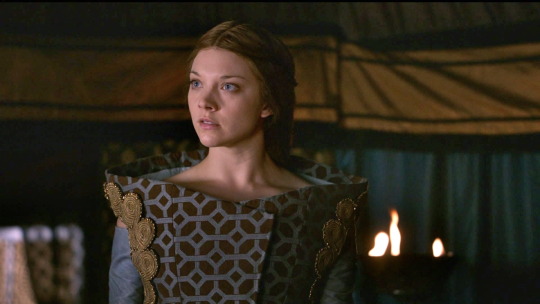
This is the second part in a series of metas about Margaery Tyrell in Game of Thrones (Part 1). In the first part I wrote about Margaery’s narrative arc and her characterization in season 2 - the season where’s she first introduced. In this post I will take a closer look at her costumes in this season.
Costume design is a particular interest of mine and Game of Thrones has some of the most interesting costumes on television - especially when it comes to the female characters. The award-winning costumier Michele Clapton’s work for the show is very original and in several cases visually arresting. However, a lot of fans have complained that the costumes are not medievalist enough. While I do think that this argument has some merit, I personally have no problem with the fact that Clapton’s work isn’t very medievalist. Whilst the feudal society of Westeros is largely inspired by 15th century England, it is also a fantasy world and that means that the costumes don’t necessarily have to be period specific.
Clapton’s decision not to go medievalist is a conscious choice since she has previously worked on period pieces such as the Jane Austen adaptation Sense & Sensibility (2008) and the English Civil War drama The Devil’s Whore (2008), for which she won a BAFTA. Instead, she has chosen to take inspiration from both history and high fashion:
“I look at contemporary fashion and art,” she says. (x)
When it comes to the costumes of Game of Thrones, Clapton have taken a very eclectic approach with inspiration from a number of different sources: historical costume, contemporary couture and vintage fashion. While her costumes may not be “historically correct”, which btw is a bit of an anachronistic concept when it comes to fantasy, her eclectic approach has yielded a number of original and iconic costumes that have prompted a number of articles in various news outlets.
Whilst a number of fans have decried her costumes as ugly, they overlook the fact that in television and cinema, costume design is not just about making pretty clothes - rather it is about supporting and articulating the characterization in relation to the narrative.
Even in real life, clothes is more than just about functionality and aesthetics. It is also a form of communication, which is why there’s an entire discipline dedicated to the communicative aspects of clothing that is called fashion semiotics.
Semiotics is the study of how people understand or make sense of life events or relationships. It is the study of sign processes and meaningful communication. Likewise, fashion is a language which holds a symbolic and communicative role. It helps express one’s unique style, identity, profession, social status, and gender or group affiliation. Therefore, the semiotics of fashion is the study of fashion and how humans symbolize specific social and cultural positions through dress.
Garments are non-verbal signs that can be interpreted differently depending on the context, situation or culture. Hence, fashion significance is constructed depending on culturally accepted codes. For example, in Western cultures white color is chosen for weddings because it represents purity while in Asian cultures this color means death and is most likely used in funerals.
Dress codes identify individuals within a culture. (x)
The same thing applies to how costumes work as meaningful elements in a visual narrative - and this is exactly the approach that Michele Clapton has adopted for her work on GoT:
For her, the key is looking at costume design as a mode of storytelling. “It’s so easy to draw a pretty dress in a fun way,” Clapton told Fast Company. “But this is so much more about finding the right look and telling so much more about that character, and that’s what I really, really enjoy: the storytelling.” (x)
Therefore, when we look at the costume design in this show, we have to ask what it says about the characters.
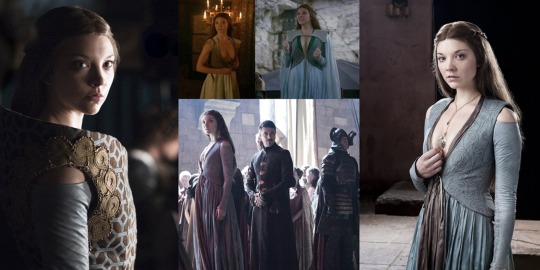
So what does Margaery Tyrell’s costumes say about her in season 2?
BOLD AND SEDUCTIVE
Margaery has three different costumes in season 2. Two of these dresses have the same basic design and silhouette whereas the third is perhaps one of the most unique costumes in the entire show. I’m going to start with a look at the gown we see in Margaery’s last scene in season 2 - the light blue gown with the rocaille pattern on the bodice.
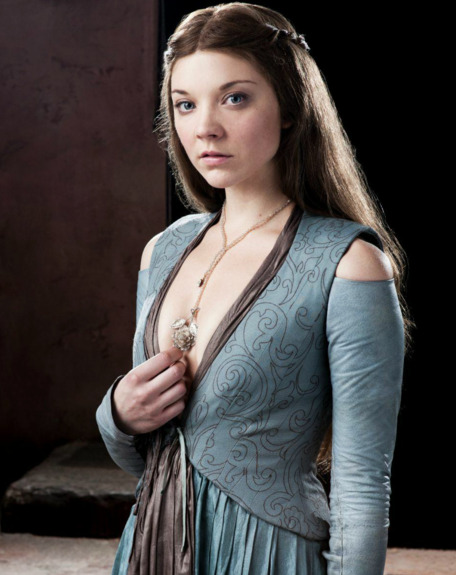
Unlike the red-gold costumes of the Lannisters in season 2, Margaery’s costumes don’t use the green-gold colours of House Tyrell. This is something that a number of fans objected to but this article argues that the use of light colours such a soft blue and purple serves as a subtle contrast to the power dressing of the Lannisters. The Tyrells are just as ambitious as the Lannisters but they are subtle about it and with the use of soft colours, they make themselves look non-threatening whilst they secret plot to extend their political influence.
This dress also feature a rocaille pattern on this bodice. In an art historical context, rocaille denotes an exuberant and elaborate form of ornamentation associated with the rococo style of the 18th century.

The aristocratic culture that the rococo style is associated with was in many ways a hedonistic, sophisticated and somewhat frivolous culture that put a lot of focus on the love of pleasure. In the context of this costume, the use of the rocaille pattern may serve as a hint that the culture of the Reach, which the Tyrells rule, is one associated with abundance, pleasure and cultural sophistication.
Another aspect of this costume is that it is quite revealing - as we’ll see in season 3, the costumes of Margaery Tyrell and her ladies feature a lot of cut-outs as well as plunging necklines, which hints at the warmer climate of the Reach as well as a more hedonistic culture than what we see in the North and the Crownlands. The most noticeable element of this dress is the plunging neckline, which emphasizes Margaery’s bold sexuality. However, the revealing nature of this gown also works at a metaphorical level:
Cersei hides behind her clothes, and Margaery instead chooses to expose herself. A very nice and metaphorical way of showing to the people at King's Landing that she has nothing to hide. This also allows her to expose large amounts of skin, which not only helps cement the idea that the Tyrells come from a warmer weather (as mentioned earlier) but also helps cement the idea that she uses her sexuality and femininity as a political tool in itself. Presenting herself as a young, delicate and alluring girl, she avoids being perceived as a player in the game, even though she very much is. (x)
It is thus ironic that Margaery wears this particular outfit in a scene where she is dishonest when she talks about how she’s come to Joffrey from afar. In this scene Margaery acts bashful and girlish, the role of the innocent maid, which the audience already knows is an act.
During the entire conversation between Joffrey, Loras and Margaery, she utilizes a specific kind of performative femininity, i.e. she tailors her courtly performance so it conforms to a very specific ideal of femininity: the bashful and innocent maid. Notice how she initially keeps her gaze lowered, signalling meek sub-mission. When Joffrey professes his admiration of her, she lifts her gaze and bats her eyes at him, which is a very calculated move. (x)
This is underscored by a costume where the sexy neckline stands in contrast to the softness of the light blue colour. In this context, it is interesting to compare and contrast Margaery’s costume with one of the dresses that Sansa Stark wears in season 1.

Whilst the colour is very similar, the cut and silhouettes of the two gowns couldn’t be more different. Sansa’s gown is modest and loose, hiding her body, whereas Margaery’s gown is close-fitting and very revealing. This highlights the differences between the two characters. Sansa IS an innocent young girl whereas Margaery is a sexually confident woman who simply plays the role of the bashful maid.
FASHION QUEEN
Let’s take a look at the costume Margaery wears when the audience is introduced to her character. First of all, this gown is identical in design to the light blue gown I mentioned above. However, in this scene Margaery has donned a rather unconventional cloak that stylistically sets her apart from any other female character we’ve seen so far.
Like the gown above, this outfit emphasizes Margaery’s confident sexuality. Not only does it have a deeply plunging neckline but the beaded strings that are attached to the button at the front of the cape serve to draw visual attention to her exposed cleavage.

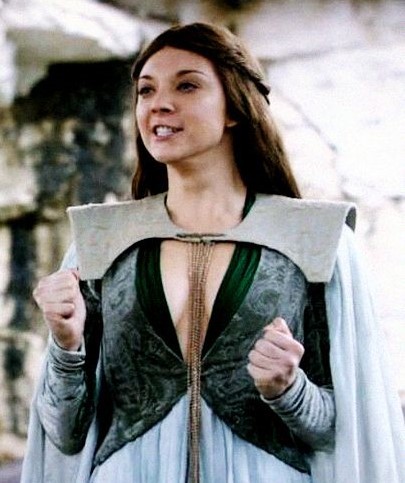
Apart from the plunging neckline, the most visually arresting element of this costume is the structured shoulders of the billowing cloak. This gives the outfit a slightly armoured “feel”:
She dons a billowing cape with structured shoulders that give a sense of armor. It is interesting to note the armor-like aspect of most of Margaery’s season two outfits. She spends the majority of the season at Renly’s camp in Storm’s End while the Tyrell/Baratheon forces prepare for war. Without the security of castle walls for protection, perhaps this is her more feminine way of being always armed and on guard for whatever is in store. (x)
The armoured aspect is an interesting one in terms of character. However, in relation to this costume the armoured “feel” of the shoulder piece takes on a rather tongue-in-cheek aspect since it is paired with a very lightweight fabric that billows in the wind. This is play-acting, which resonates perfectly with Margaery’s presence at a tourney where knights play at war whilst a real war rages elsewhere. However, this costume also signals that Margaery is fashion-forward in a sense few other Westerosi women are. She’s the consort of a royal pretender who wants to present an alternative to the current regime - and Margaery mirrors that by setting herself up as stylistically different, as a future taste-maker.

It is interesting to note that Margaery wears a kind of scarf underneath the bodice in order to make the neckline LESS revealing. The tent scene with Renly shows EXACTLY how deep the neckline really is.
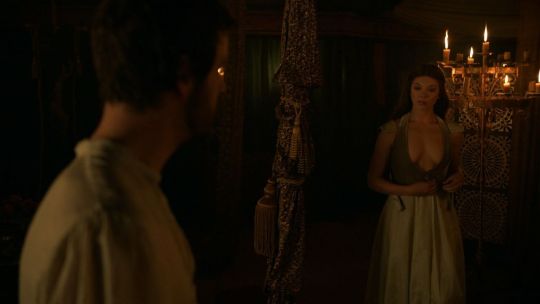
Here the revealing nature of the costume supports both the narrative and the character. In this scene Margaery tries to seduce her reluctant husband but she also reveals her pragmatic nature - as I’ve detailed in my previous post.
ARMOURED IN FASHION
The third costume that Margaery Tyrell wears in season 2 is perhaps the most avantgarde and also the most controversial costume on the show. I am, of course, speaking of the now infamous funnel dress that Clapton designed as an homage to Alexandre McQueen’s iconic Bell Dress that he made for Björk in 2004.

Margaery's funnel dress was obviously an homage to the wonderful Alexander McQueen's costume for Bjork. It just felt right that this young ambitious girl would be experimenting with shapes, honing her style skills which we now see her employing to great effect. It was a risk and divided the audience. (x)
“From the very beginning she is brave and experimental in her look, which I wanted. She was a young girl who wanted to be the queen,” Clapton explained.
Margaery is often spotted in revealing or outré outfits. One episode she wore a funnel dress that Clapton told Vogue was an homage to an Alexander McQueen dress made for Bjork. “It was ridiculous. She’s a teenage girl trying things out.” (x)
Clapton designed this dress to emphasize that Margaery is rather avantgarde in terms of style. She’s experimenting style-wise but this look is so radical in relation to the rest of the fashions of Westeros that I cannot help but think that she’s also trying to create a new paradigm. She wants to stand out, to be seen as different from everybody else.
Another aspect of the funnel dress is that it has an armoured “feel” that is even stronger than the structured shoulder piece she wears at the tourney. The dress itself is made from a much heavier fabric than her low-cut, lightweight dresses and it has a very structured silhouette - and in contrast to her two other gowns it covers her completely.
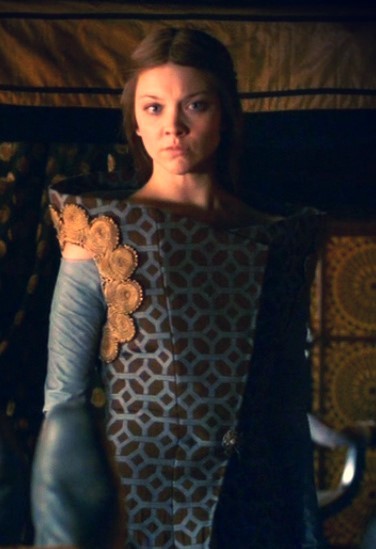
The funnel dress essentially functions as a structured coat-dress that Margaery wears over one of her more revealing dresses. If you look closely, you can see that the blue sleeves with the cut-outs over the shoulders match the seductive blue dress that she wears in the scene where she’s betrothed to Joffrey.
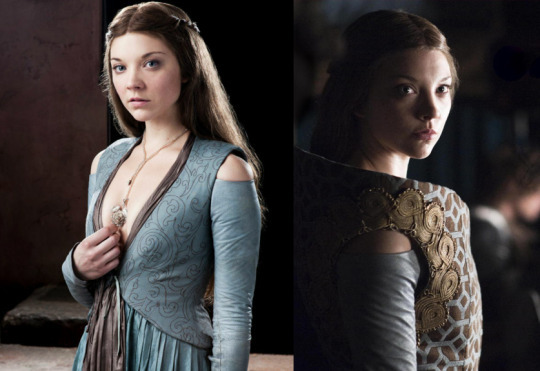
Once again, the costume design supports the overall narrative since Margaery wears this dress in two scenes where she is in a defensive position - Lady Sansa Stark was taught that courtsey is a lady’s armour but for Margaery, fashion can be armour as well:
We witness Margaery’s armor full-on with her infamous “cone-dress”. She wears this in two scenes, and is speaking with Littlefinger in both. She knows this is a man with whom you must always be on your guard, and this is reflected in the heavy satins and silk embroidery, but she keeps her shoulders exposed just enough to maintain a feminine air. (x)
It is noteworthy that Margaery only wears this dress in scenes where she is in a defensive position. The first time in the scene with Baelish where he’s questioning the status of her marriage to Renly and the second time after Renly’s death where Margaery is quietly scared because she knows exactly how dangerous the situation has become for both herself and her family.
TOO AVANTGARDE?
The funnel dress turned out to be a very controversial costume in terms of audience reception. It was the subject of a number of think-pieces but here I’ll just focus on article since its arguments exhibit a couple of different argumentative fallacies.
Let’s get the obvious out of the way first: this costume is ugly. It has no redeeming qualities. It isn’t fashion-forward in any sense. It isn’t interesting. It isn’t even well-made (note the seam where the pattern does not align: on the front of the damn garment!). I can’t even give credit where credit is due regarding the embroidery, which must have taken hours, because the embroidery is so ugly. (Fandomentals)
It is a perfectly valid opinion to say that this dress is ugly. It is, after all, a matter of taste. However, the quote above is followed by this little tidbit:
....the sheer and objective ugliness of this costume. (Fandomentals)
It is one thing to say I don’t like this dress, it is another thing to call it “objectively” ugly as this is just manifestly wrong. When it comes to aesthetics, beauty is always in the eyes of the beholder. Presenting a subjective opinion as an objective fact is a bad faith argument and it undermines what the author’s point.
Then they go on saying that such an avantgarde dress is unbelievable in a feaudal society based on the medieval period of European history - conveniently ignoring that there plenty of outrageous and not very functional fashions has existed throughout history.
While there are fashion trends in Westeros, there isn’t high fashion as we know it today. No one is picking bizarre pieces off the runways in Milan or opining over Vogue. There are no catwalks in the Reach, and there is no King’s Landing couture (though I wish there was!). Westeros is a world based on medieval human history, where men and women wore clothing to express their status in society. Clothing served a functional purpose and certainly did not step out of the norm to this extent. (Fandomentals)
It is also an argument that displays a lack of knowledge about the history of dress. Whilst there was no fashion industry in the middle ages and the renaissance, the concept of fashion as related to clothing styles did in fact exist as early as the 12th century:
How are we to distinguish between a culture organized around fashion, and one where the desire for novel adornment is latent, intermittent, or prohibited? How do fashion systems organize social hierarchies, individual psychology, creativity, and production? Medieval French culture offers a case study of "systematic fashion", demonstrating desire for novelty, rejection of the old in favor of the new, and criticism of outrageous display.
Texts from the twelfth and thirteenth centuries describe how cleverly-cut garments or unique possessions make a character distinctive, and even offer advice on how to look attractive on a budget or gain enough spending money to shop for oneself. Such descriptions suggest fashion's presence, yet accepted notions date the birth of Western fashion to the mid-fourteenth-century revolution in men's clothing styles. A fashion system must have been present prior to this 'revolution' in styles to facilitate such changes, and abundant evidence for the existence of such a system is cogently set out in this study. Ultimately, fashion is a conceptual system expressed by words evaluating a style's ephemeral worth, and changes in visual details are symptomatic, rather than determinative. (x)
Secondly, fashion trends most certainly did exist in the past - just not in the forms we know today, i.e. supported and embedded in an industry. During the medieval age, the renaissance and the baroque the taste makers who set the fashion where individuals, royal and aristocratic men and women. There are numerous examples of aristocratic fashions that were not about function but about display. What this writer fail to understand is that all clothing is part of the semiotics of fashion. Clothing and bodily decoration have always been both about beauty as well as about signalling social standing and/or political affiliation. ALWAYS.
Thirdly, costume design is an integral part of the visual story-telling and thus the costumes serve a larger function than just world-building. The relation between story-telling and costume design is something that Clapton herself emphasizes:
...viewers should consider the bigger picture and storyline to understand costume choice–or even to look for hints about how a character is evolving. “I don’t think any costume should be looked at in isolation, rather, through the arc of the character,” Clapton says. “Each thing will tell a story. It might look like a costume is wrong, but actually it’s supposed to look like that. It’s telling you something about the character at the time.” (x)
Ultimately, the question is not whether Margaery’s funnel dress is ugly, pretty or historically correct. It serves a narrative purpose and it serves it well as I’ve argued above. Not only does this dress reflect Margaery’s bold personality but it also functions as her armour in situations where she is in a defensive position and in that context I find that this particular costume makes perfect sense.
A QUEEN WITHOUT A CROWN
There’s one final detail that I want to address. Unlike her husband, Margaery doesn’t wear a crown even though she is addressed as Your Grace, which is a title reserved for royalty. From a Watsonian perspective it would make sense for Margaery to wear a crown since she’s the consort to a man who has proclaimed himself king and who wears a crown himself.
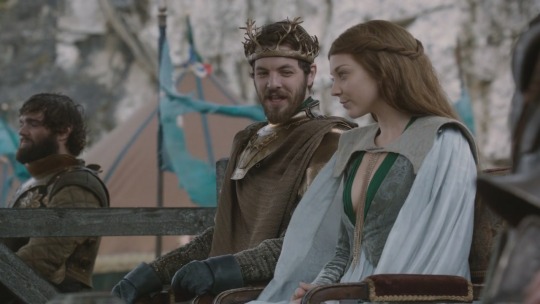
However, in this case, Margaery not wearing a crown is connected to her narrative arc. In the scene with Baelish where she proclaims that she wants to be THE queen, Margaery has come to realize that “Calling yourself a king doesn’t make you one”. She realizes that Renly wasn’t really a king and therefore she wasn’t really a queen. Clapton pays attention to details like this and that is why she didn’t make a crown for Daenerys in season 7:
Well, she's not the queen yet. You can't have a crown until you are queen. You can have the chain, but until you get the throne you're not queen. (x)
Thus, the fact that Margaery never wears a crown during her short-lived marriage to Renly is less about world-building and more about the narrative.
Thanks to @lilbreck for the edits.
121 notes
·
View notes
Text
JOE DALLESANDRO: Body Worship
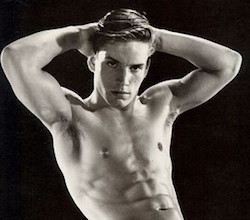
The faces and voices of movie stars past and present continue to be extensively written about and well covered, but what about the bodies on the screen? We saw most of Rudolph Valentino’s body, and enough of Clara Bow to want more. Jean Harlow iced her nipples to make them stand out and up at attention under her gowns, and Tyrone Power loved to wear the tightest possible pants to display his lower extremities. It was only in the 1950s, though, that Marilyn Monroe and Marlon Brando tested the limits of their clothes and wantonly imposed the fleshiest grabbable flesh. In the 1960s, the women in movies started getting rail-thin while one muscular and fleshy man took all of his clothes off on screen without any self-consciousness. In the area of exposing and idly flaunting on-screen flesh, this man is the all-time champion, and much more besides.
His name was and is Joe Dallesandro, a kid from the mean streets of New York who stole cars and went to reform school and acquired a scar on his knee after a gun battle with police. As a teenager, he began posing for nude photographs out in California, and he learned how to hit up gay guys for bread. “I’d come from New York where I’d seen people do the hustle,” Dallesandro said, “and I knew people could get away with anything if they just knew what to say. My hustle was about getting anything I could for nothing.” Back in New York at age eighteen in 1967, Dallesandro wandered into a Greenwich Village apartment where a movie was being shot, an underground movie made under the auspices of Andy Warhol and his Factory but controlled by Paul Morrissey, a mysterious, conservative figure who looked at Dallesandro and immediately liked what he saw.
Dallesandro went out to Arizona with the Warhol crew to make Lonesome Cowboys (1968), a queer anti-western where he does a hilariously open and polymorphously perverse little dance with sprightly Taylor Mead and is coached to do ballet pliés by another cowboy in order to build up his legs and butt (which certainly needed no building). At one point in San Diego Surf (1968), Warhol superstar Viva accidentally drops a baby and Dallesandro moves with a lightning fast reflex to catch it. At this point, it was clear that Dallesandro had a beautifully balanced and open face, with a sunburst smile that made him look innocent and childlike, and a body to make Michelangelo all hot and bothered. But he also had the pinched voice of a New York wise guy and skin that made it look like he probably ate mainly pizza. This contrast moved Morrissey, and maybe he was also moved by the knightly, responsible way that Dallesandro caught that baby before it fell to the ground.
In 1968, for very little money, Morrissey created a whole vehicle just for Dallesandro called Flesh, a film that nods to earlier Warhol experiments by opening with a two-and-a-half minute shot of Dallesandro’s sleeping face. After being rudely awakened by his demanding wife (Geraldine Smith), Dallesandro passively complains that she never does his laundry; he says a man’s job is protecting his family. He is wearing nothing but a cross around his neck.
Put-upon and beguilingly passive, standing in the street waiting for guys who might give him some money for nothing or for something a little more, Dallesandro in Flesh is as un-self-conscious as Louise Brooks in Pandora’s Box (1928), but his energy is more inward-directed. He doesn’t “act” so much as enter fully into any scenario Morrissey has given him like a little kid playing “let’s pretend” in their backyard. Every kid plays “let’s pretend,” but some kids are just more fun to play with than others, and the camera picks up on that, just as the person directing behind the camera can become entranced.
There are close-ups of Dallesandro in Flesh that stop the movie dead in its tracks. Like Marilyn Monroe and James Dean, Dallesandro knew exactly what to offer to a still camera, assuming all the attitudes from Back Off to Come Hither to Take Care Of Me. And always, essentially, he is distant and removed, which is his real trick, the thing that keeps people coming back for more. Often fully naked on screen, Dallesandro offers all of that bounty to the camera, but he keeps himself to himself.
In Lou Reed’s hit song “Walk on the Wild Side,” one section claims, “Little Joe never once gave it away/everybody had to pay and pay.” But Morrissey in Flesh is saying, even howling, yes, you can all have or stare at his body, but look at who he is! Look at all the beauty there in his face, in the way he moves, and particularly in his innate sense of masculine responsibility. He’s very funny in Flesh when he looks frankly bored and forlorn with some of his chattier clients, like a kid made to stay after school in detention who would much rather be outside, but his face is usually such a patient face, a stoic face, and always rivetingly photogenic. Maybe his screen presence is a bit of a hustle, too, but if it is, I’ll gladly pay and pay.
Morrissey’s conservatism might not come through as strongly as he thinks in his early films because he often ceded them to charismatic speakers for hedonism like Holly Woodlawn, who made a comic and tragic thing of her love for Dallesandro in Trash (1970). In that movie, Dallesandro plays an impotent drug addict who seems more dead than alive as women and men paw him and clutch at him. When Woodlawn is forced to use a beer bottle to get off sexually, Morrissey makes sure to cut to a close-up of Dallesandro holding her hand, one of the most moving images of tender disconnection in all of cinema.
Morrissey played Svengali with Dallesandro, who worked at Warhol’s Factory, trying to mold him into an ambiguous and unchanging star like John Wayne or Marlene Dietrich (at this time, Morrissey often spoke of wanting to remake The Blue Angel {1930} with Dallesandro playing Dietrich’s role of the inactive femme fatale Lola-Lola). In Morrissey’s Heat (1972), Dallesandro is cast as a washed-up child star angling for a comeback amid the hothouse improvisations of Sylvia Miles and Pat Ast. He has moved even further into a kind of waiting catatonia, but even at his most sedentary and unresponsive, Dallesandro signals that he is always on the make, occasionally throwing out a zinger when you least expect it just to prove that he can pay close attention to what’s going on around him when he wants to (but he usually doesn’t want to). Morrissey took his star to Europe to make back-to-back horror films, Flesh for Frankenstein and Blood for Dracula (both 1974), where Dallesandro has his funny, incongruous moments but mainly takes a backseat to the campy authority of Udo Kier.
Dallesandro decided to strike out on his own in the mid-1970s, and the results were rich and varied. “How’s it goin’?” he nonchalantly asks a moaning woman he is humping in Donna e Bello (1974), checking on her pleasure before sneaking a look at his wristwatch, like Jane Fonda does in Klute (1971). He made a lot of films in Italy where he was cast as psychos on crime sprees, yet those movies still captured moments of film-stopping purity in his face.
This quality he had was picked up on by Louis Malle, who made Dallesandro look princely and storybook-like in his experimental feature Black Moon (1975). Best of all in this period, Dallesandro appeared in Je t’aime moi non plus (1975), a vibrantly strange road picture directed by bad boy French songwriter Serge Gainsbourg. In that movie, Dallesandro plays Krassky, a gay truck driver who falls for Johnny (Jane Birkin), a roadside waitress. Maybe it’s because he’s dubbed in French, but in this movie something very romantic and almost Byronic emerges in Dallesandro, with elements of the goofiness that he had shown when he danced with Taylor Mead in Lonesome Cowboys.
While working in Europe, Dallesandro collaborated with a remarkable array of intriguing directors. In Walerian Borowczyk’s The Streetwalker (1976), Dallesandro himself pays for lady-of-the-night Sylvia Kristel. For the young Catherine Breillat, he was a sex object to a female director in Tapage nocturne (1979). During the making of Jacques Rivette’s Merry-Go-Round (1978, but only released in 1981), Dallesandro, his co-star Maria Schneider and Rivette himself were all in despair and trouble of some kind in their personal lives, so that the film has a very unsettling air of real desperation underneath Rivette’s suggestive, paranoid mise-en-scène. This is Dallesandro’s most touching work on screen. Even though he seems at the end of his tether in Merry-Go-Round, he still tries his very best to make sense of it all, like a kid trying to play a game when the rules of that game keep changing. Again, what comes across here is Dallesandro’s helpless sense of responsibility, the fact that he cares and wants to tidy up messes other people might make.
After beating a drinking problem, Dallesandro returned to the US and drove a limo for a while before being tapped by Francis Ford Coppola to play Lucky Luciano in The Cotton Club (1984), a film that he steals with his suave self-assurance in spite of limited screen time. In the movies he made after that, for Blake Edwards and John Waters and for many lesser talents, Dallesandro is never less than fully present and usually very inventively foul-mouthed. In Steven Soderbergh’s The Limey (1999), Dallesandro has a colorful small part as a slow henchman who manages to sink a shot on a pool table to his own much-evident and childlike delight. Let’s pretend!

In recent years, Dallesandro has managed a building in LA and he often single-handedly makes Facebook worthwhile with friendly quips, clips and all-around survivor humor. He’s cool with being a Sex God, skeptical of mythmaking, and quietly proud of his movies and his image. His Morrissey films secure him a place in film history, and his European work awaits further and more detailed investigation. He is an icon of a period and milieu when sex did not have boundaries, when pleasure was a vocation and a principle, and when a man taking off his clothes in front of a camera could not divert us from trying to find the part of himself that he would not give away.
by Dan Callahan
37 notes
·
View notes
Photo

Charulata (1964, India)
The first non-European to win the Nobel Prize in Literature was Rabindranath Tagore, winning in 1913 as the fourteenth laureate. Tagore, a Bengali author, represented the West’s increasing awareness of one aspect of Indian culture, just as Western filmmakers and moviegoing audiences became more aware of one aspect of Indian culture through Satyajit Ray’s films. Ray and Tagore come together in Charulata, Ray’s cinematic adaptation of Tagore’s novella Nastanirh. Nine years after his self-taught directorial debut, Ray had quickly become one of the most prominent figures in international cinema, and he himself believed that Charulata represented his work, “with the fewest flaws”. Also known as The Lonely Wife in English, Bengali-language Charulata requires some knowledge of Indian history and society, specifically its colonial ties to Britain and especially gender-informed attitudes towards women. Though I agree with Ray’s assessment of Charulata’s polish – of the seven movies of his I have seen – I would not say this is his best movie. Considering the quality of his work, even his lowest-standard work is worth witnessing.
Our setting is Calcutta, sometime in the late nineteenth century. Charulata (Madhabi Mukherjee, whose character is referred to as “Charu”) lives with her husband Bhupati (Sailen Mukherjee; no relation to his co-star) in their two-storied, terraced home. She is a housewife who reads any literature and poetry she can find in her spare time; he is the editor of a political newspaper supporting Indian independence. Bhupati’s offices are in a different section of the house, where women are not expected to be, if not outright barred from. So Charu’s days, when she is not reading, are often tedious. Her room, the house’s high walls, and an expansive backyard are all that make up her world. Not that Bhupati is unaware of his wife’s loneliness; he employs his elder brother Umapada (Shyamal Ghoshal; barely in this film) so that Charu has company with his wife, Manda (Gitali Roy). But Manda is too frivolous for Charu. So when Bhupati’s cousin Amal (Soumitra Chatterjee) arrives, Bhupati encourages Amal – a writer – to cultivate Charu’s literary interests.
What follows is a connection between two creative souls as intense as could be imagined. Charu and Amal might not be culture-shaping, headline-writing creators (yet), but their passions are sincere, stemming from their life experiences in times of self-discovery. Passing interests become a lifestyle. Love intermingles with rivalry, competing love. Ray, who also wrote the adapted screenplay and composed the theme music, is able to contain complicated emotions into uncluttered stories. In Charulata, that means planning out a seven-and-a-half-minute opening scene where there is almost no dialogue to introduce the audience to Charu – her personality, her dreams, her isolation. A less confident and skilled director-writer might use narration or spend double or triple that time to depict a character’s interactions with others to grant the audience a portrait of what we need to know about a character.
Permit me a fantasy, but it is moments like these – and countless others during Ray’s Apu trilogy – that make me wonder if Satyajit Ray would have been a transformational force in silent film had he been born some decades earlier. For he is excellent in strategizing and writing out moments where nary a word is spoken, where ideas and feelings are conveyed through the simplest things such as where a character has positioned their body, who or what are they looking at, and what they might be doing when no one else is in the vicinity. In a film where the characters use words to express themselves naturally, Ray needs no words to do so. This diligence is something not often thought about when a Ray movie (or anyone else’s movie, for that matter) is playing. Yet that attention in Ray’s screenplay to granular details is what inspires Charulata’s pathos, as well as in the Apu trilogy and 1966′s Nayak.
Yet there are moments in Charulata that will escape Western viewers. Writing for British film magazine Sight & Sound in 1982, Ray noted that some of the authors mentioned and alluded to in the film as well as songs used will only be accessible to those knowledgeable about Bengali culture. Repeated references to nineteenth century Bengali author Bankim Chandra Chattopadhyay appear in the opening minutes. In the aforementioned opening scene, Charu quietly sings Chattopadhyay’s name to herself. Minutes later, Amal arrives at his cousin’s house – his hair wet, his clothes dirty from the storm outside – and quotes from Chattopadhyay, underlining an intellectual and emotional connection to Charu that lovers of Bengali literature will recognize instantly. And if you were wondering if I knew about all of this beforehand and am the most adventurous person when it comes to non-English language literature, the answer is no: I looked it up. This review and this blog is written for an English-speaking audience, and the expectation is that English speakers will take the most out of these movie write-ups. This point on Bengali literary references is just one illustration of how Charulata – which is comprehensible for Western viewers without knowledge of Bengali literature – is operating in meticulous ways that are known and unknown to us viewers.
Here is another point unknown to most in the West: Ray’s adaptation of Charulata concentrates on Charu, shifting the Tagore novella’s focus away from Bhupati. Literary critics of the Tagore novella have noted how its narrative concentration on Bhupati showcases how oblivious he is to his wife’s dissatisfaction with her life. Ray, by entitling his film Charulata and by giving Madhabi Mukherjee far more screentime than Sailen Mukherjee, attempts a feminist approach that mostly works. The complete lack of women engaged in political debates in the household and the newspaper’s headquarters displays, without pontification, how women were discouraged from engaging in, let alone speaking about, the nation’s politics and relationship to the British. Though Charulata seems to be supportive of her husband’s pro-independence positions, the film suggests how Indian women, in this case Bengali women, are more connected to certain populations and policies than Bengali men. The absence of feminist voices creates an echo chamber of self-confirmation – creating an environment similar to the undeserved air of confidence Amal exudes when contemplating his relationship to his wife. A similar dynamic can be applied to Amal’s beliefs – though not as damagingly masculine as his cousin’s – about the role of women in Bengali literature.
The budding relationship of Charu and Amal first exists in a place familiar, confining: a private sphere where women are restricted in action and thought. Charu attempts to reclaim this space as hers, asking Amal to never reveal the poetry he writes in her company to others. These verses are written in a personal notebook Charu gives to Amal. That sort of request goes beyond forbidden friendships and love affairs. Those words, composed in a particular place, supported by the care of a particular person, might have been written by Amal, but Charu feels some sense of ownership, too. This is a new experience for Charu, to see someone engaged in a creative process, let alone designating her as his muse (”muse” is used here not necessarily to connote romantic objectification as occasionally implied, and will be best understood when one views the film). So when Amal violates that trust, Charulata begins to resolve as a narrative, to the only conclusion that might be bearable for the three central protagonists.
Without the performances from the Soumitra Chatterjee and Madhabi Mukherjee, Charulata would not be as impactful as it is. Mukherjee, with her wondrous expressions and facial acting, is incredible as the titular character. In the film’s quietest, stillest moments, she is occupying her character’s life – her pangs of joyfulness and frustration etched on her forehead, eyes, and so many frowns – and showing the audience all that needs to be known as early as possible. It is a stunning performance. Second to Mukherjee is Chatterjee, balancing playfulness and an unwieldy amount of the film’s most visible empathy for Charu. Soulmates though Chatterjee and Madhabi Mukherjee might play, their characters have varying levels of comfort in how they approach sharing their interests with others. There is the necessary narrative friction here, and their performances make the finale all the more crushing for everyone involved – yes, even for Shailen Mukherjee’s negligent Bhupati.
Cinematographer Subrata Mitra – a Ray regular – and his tracking shots float across the house, only venturing outside for the film’s ten-minute scene in the backyard garden, with Soumitra Chatterjee swinging herself back and forth. It is evocative camerawork, unafraid of almost invasive close-ups meant to mark a character’s discomfort with the current situation. The final shot of Charulata is the stuff of vehement mixed opinions (I believe the effect to be unnecessary). Art director/production designer Bansi Chandragupta consulted with Ray well before shooting began to examine Ray’s blueprints of the household – carefully sketched like an architect’s work, along with furniture that Ray thought appropriate for the household. Chandragupta’s and Ray’s sets are a mix of traditional Indian and European designs, reflective of the worlds Bhupati is torn by and the upper-class privilege he thinks little of.
Satyajit Ray is not a director known for unambiguous conclusions, unscathed consciences. Charulata represents one of the most jagged conclusions he has directed and written, designed to linger long after the credits have finished. For Bhupati and Charu, their nest of comfort and homeliness is broken. For Amal (and perhaps Charu, too), what was once a haven has become a reminder. Heartbreak needs no translation.
My rating: 8/10
^ Based on my personal imdb rating. My interpretation of that ratings system can be found here.
#Charulata#Satyajit Ray#Rabindranath Tagore#Soumitra Chatterjee#Madhabi Mukherjee#Shailen Mukherjee#Shyamal Ghoshal#Gitali Roy#Subrata Mitra#Bansi Chandragupta#TCM#My Movie Odyssey
7 notes
·
View notes
Text
Chapter Twenty-Two : LA CAGE AUX FOLLES DOGMA

Dogma : the official system of principles or doctrines of a religion or the positions of a philosopher or philosophical school.
In 1973 at the Théâtre du Palais-Royal, took place the first official performance of La Cage Aux Folles written by Jean Poiret, a vaudeville centering on confusion that ensues when the son of a night club owner and his main star (also a man) brings his female fiancée’s ultraconservative parents for dinner. An incredible success on stage, it went on the run for close to 2,000 performances.
Five years later, La Cage Aux Folles was adapted into a movie directed by Edouard Molinaro. You want to talk about phenomenon ? It became the second-highest grossing movie in France that year, with 5,406,614 admissions and is till the 10th highest grossing french movie in the U.S.
It was later adapted into a Broadway musical in 1983 with Harvey Fierstein at the helm (see article from June 2nd), and a remake was shot in 1996 directed by the great late Mike Nichols called The Birdcage.
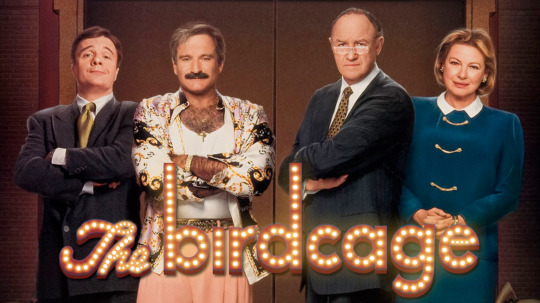
I have to tell you that right now, I hate La Cage Aux Folles. It has little to no qualities in terms of production value and cinematic interest and most of all, it’s probably one of the most offensive movies in the History of cinema for LGBTQ+ people. But it was also a product of its time, enslaved by moral codes and infused by a lack of comprehension that is ours today.
That’s what I want to talk about here. Representation.
It ain’t pretty. Like Michel-Serrault-in-drag-not pretty.
HISTORICALLY VILE
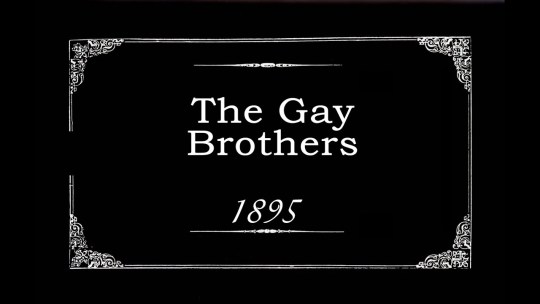
The first representation of homosexuality in cinema was in 1895’s short silent film The Gay Brothers. We can’t really know for sure because
1. homosexuality was not common knowledge back then
2. Gay didn’t mean Fag in the late 19th century
3. two men dance together while a third plays the fiddle. Conclude for yourself.
Anyway, the movie intends to be comical and makes a lot of jokes at the expense of its protagonists. Trend-starter, that one.
As movie making was booming, increase awareness and presence of Queer people appeared in that media. Unfortunately, the rise of the Production Code (created in 1922) brought a lot of censorship to the community in its possibility of portrayal.
Homosexuality was never explicitly mentioned and only in two ways : as a comical device or a villainous character who’s sickness, perversion and crimes are obvious to the audience.
When it came to homosexuals, worldwide viewers had three options to explore : laughter, pity or fear.
Early on, the girlish traits of the gay character and the stupidity of its desires were put front and center, whether in westerns (The Soilers) or in Charlie Chaplin movies (Behind the Screen). In historical movie term, the character would be referenced as the SISSY. Answering to the same principles as the whore, the dad or the saint figures, the SISSY had for purpose to give more masculine value to the hero (and to the viewer). But as the butt of the joke and in the constraints of the Production Code, he didn’t have a proper sexuality to act. An innocent childish fool.
This convention continued with the talkies in the 20s and 30s as a subject that was partially shown but never discussed.
The few non-judgmental attempts at depicting Queerness were met with furious reactions and indescribable indignation from religious audiences, like when Marlene Dietrich kissed a woman on the lips in Morocco (1930), causing reinforcement of the Code.

For over two decades, scripts would pass through intense censorship and oppression, erasing homosexual overtones in novel adaptions or changing too direct gay references and replacing them with anti-semantic plot lines, more line with the time.
To override the code, directors had to be extremely smart. Alfred Hitchcock, a master of all movie crafts, was the best at this game. In 1948’s Rope, two roommates kill another man to finally know what it feels like, then host a dinner party in their apartment while the body is still there. The movie is fascinating in its “one-shot” concept and the script never mentions the possibility of a sexual relationship between the two but if attentive, you realize that they live in a one-bedroom apartment. Since you’ve spent the entirety of the movie in the living room, you know no one sleeps here. So. They gay. They’re also despicable murderers. Yep. FEAR factor.
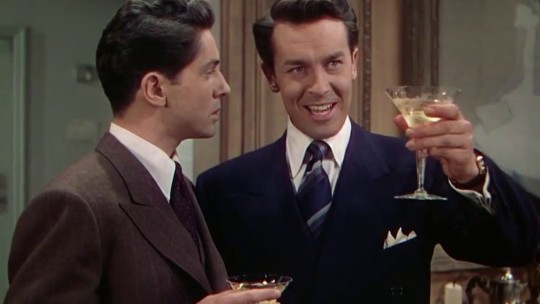
I have so many more examples of this but let’s fast forward to the late 50s and the end of the Production Code’s dominance on Hollywood. 1959’s Some Like it Hot depicts two male protagonists pretending to be women who join a musical touring band. Straight people dressed in woman’s clothes. Come on, moviegoers, time to LAUGH. That movie gets a pass because Billy Wilder is a genius.
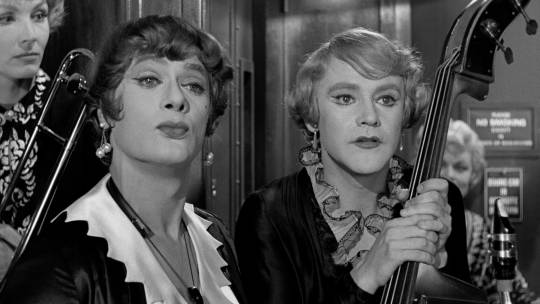
Then you have Spartacus (1960) and that homo-erotic relationship between the protagonist and its servant. Still underlined as hell but still.
Then not much else. Until…
WE GOT FUCKED (AND NOT IN A GOOD WAY)

In the States, The Boys in the Band (1970) shook things for good (and, in a lesser way, The Producers, 1968). A year after the Stonewall Riots, while homosexuality was still considered a mental illness, This play adaptation’s portraying of nine homosexuals (eight, if you’re really delusional) was revolutionary. But some of their characterizations (I’m looking at you, Emory) and the way they tear each other apart as sure-to-be closeted monsters are quite hard to watch. In a way, they are still crazy sissies. Audience, PITY those homosexual fools.
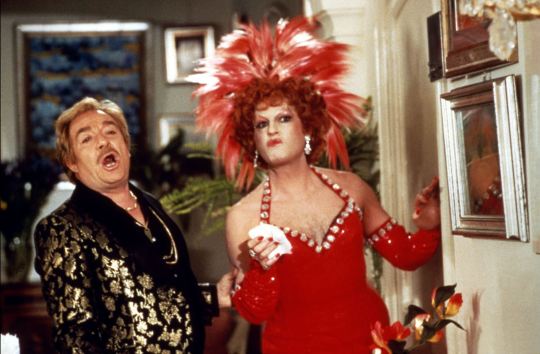
And then, La Cage aux Folles. Although France made some attempts at talking about homosexuality without obeying to the social et moral duties of the era with La Nouvelle Vague (Amitiés Particulières, 1964), it was Molinaro’s popular success that sealed audiences’ views on gay people in this brand new era.
By depicting Zaza (Michel Serrault) in such a flamboyant way, combining homosexuality, drag queens, transvestites and transgender people into one, this movie, with its truly international success, wrote unintentionally a new rulebook about what a homosexual is deemed acceptable on screen. Such rule would be followed for decades to come. Do you now understand the dogma definition at the beginning of the article? I’m a smart cookie, you know.
LA CAGE AUX FOLLES DOGMA
For a gay character to be portrayed in a major motion picture and thus be accepted by audiences, he has to :
1. Be recognizable from the straight characters, as not to confuse the audience.
2. Be funny and over the top, so that the audience don’t take offense to its immorality.
3. Reassure male audiences on their true masculinity with ridiculous ways to act, walk, talk and live.
4. If your movie embraces the gay character’s view at some point, be sure to let him make all the compromises in the world so that the audience knows that HE knows that what he is doing is ‘peculiar’ and ‘wrong’
5. Make fun OF him as much as possible. And pretend you’re having fun WITH him.
PS. Don’t forget, glitter and fun mockery.
Zaza screams his lungs out for nothing and everything. Sorry, “her” lungs out, since SHE only uses the female pronoun to talk about HERself. She performs in a gay cabaret, is clearly depicted as the female counterpart of the relationship (because you need to apply binary concepts no matter what), decides to dress as a woman to meet the conservative in-laws for the first time. Zaza is the new post-gay liberation movement acceptable SISSY.
Zaza is also a plague for the movement.
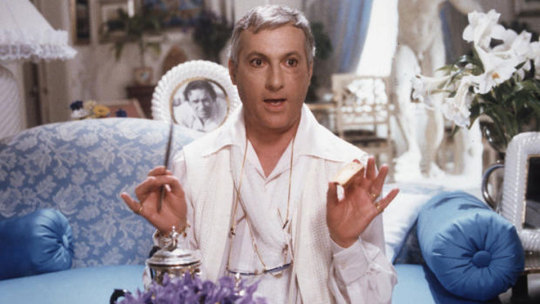
Michel Serrault, as talented of an actor as he was, doomed us for years to come by transposing a fantastic stage character into a movie ready to be assimilated by millions.
Media is power. If they say something has to be this or that, the audience will follow, especially in a time when gay people weren’t equals in rights or ready to mingle with the general population.
Critics embraced it. It was nominated for three Oscars. Serrault won Best Actor at the Césars. The Golden Globes deemed it the Best Foreign Film of that year. Talk about Media approval.
We were fucked.
THE MINORITY AFTERTHOUGHT
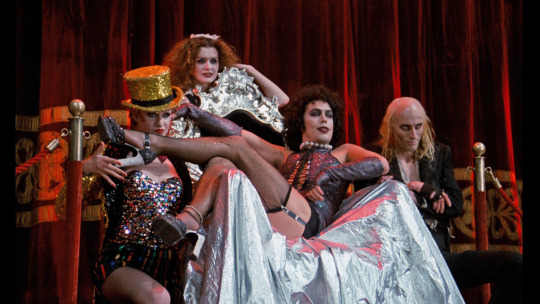
The greatest decade in cinema (in my opinion) saw the portrayal of a couple of… interesting gay characters. The Last Picture Show (1971), Cabaret (1972) and its flamboyant Maître des Lieux.
Dog Day Afternoon (1975) shocked audiences with a protagonist in a relationship with another man. Unfortunately, that other man is a SISSY who wants to have Reassignment Surgery in no way portrayed in a positive light.
The Rocky Horror Picture Show (1975) gave a shitload of screen time to Queer characters, but (SPOILER ALERT) he is an alien from another planet, a freak and the movie became a cult classic with time, it was not a studio film.
In television, gay people are nowhere to be found. Homosexuality is barely getting talked about in the news.
The Mary Tyler Moore Show has Mary go on a date with a man who turns out to be gay. It’s funny. So wacky.
Not much else.
I found a couple of shows from the 80s with LGBT plot lines .(Thirtysomething! Thirtysomething!) but the article was already way too long. Make your own damn research !
NOT THAT KIND OF SISSY

To my recollection, the first time a homosexual person was portrayed in a truly positive light was in Jonathan Demme’s Philadelphia. The struggle of a HIV-positive man seeking justice after he was fired. Tom Hanks won his first Oscar. Bruce Springsteen also won for his incredible song “Streets of Philadelphia”. I mean, it was still about pity lots of ways but the humanity in which the character is shown is outstanding. As Hanks puts it “Love is spelled with the same four letters”.

The 90s saw a biggest variety of Queer characters portrayed in american cinema. The Crying Game. Philadelphia. Jeffrey. Showgirls. My Best Friend’s Wedding. To Wong Foo, Thanks for Everything! Julie Newmar. Most of them offensive in terms of clichés (because… written by cis straight folks ? YEP). but a welcome demonstration of our colors.
Australian classic The Adventures of Priscilla, Queen of the Desert (1994) stays a example on how to do proper representation without removing the potential ridiculousness of Queer existence.
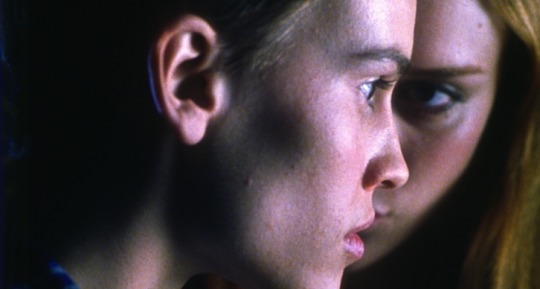
At the dawn of the new millennium, independent cinema offered us Boys Don’t Cry (1999), the true story of Brandon Teena, a trans man who tried to live his authentic life and got killed for it. More than putting Hilary Swank on the map (and an Oscar is her hands), it was unique in the sense that the queer protagonist wasn’t a joke, wasn’t scary and did not inspire pity. He was a strong man, a tuff spirit and a model for trans generations to follow.
UNAPOLOGETICALLY QUEER

Boys Don’t Cry was followed by a series of incredible movies and characters not afraid to be as Queer, as proud and as strong as Brandon Teena.
Before Night Falls (2000), Hedwig and the Angry Inch (2001), The Hours(2002), Mysterious Skin (2004), Breakfast on Pluto (2005), Kiss Kiss Bang Bang (2005), Transamerica (2005), Brokeback Mountain (2005), Kaboom(2010), Blue is the Warmest Color (2013), Dallas Buyers Club (2013), Pride (2014), The Imitation Game (2014), The Way He Looks (2014), Carol (2014), Tangerine (2015), Moonlight (2016), Call Me By Your Name(2017), A Fantastic Woman (2017), Disobedience (2017), Battle of the Sexes (2017), The Miseducation of Cameron Post (2018), Love, Simon(2018), Rocketman (2019).
Even when the gay character is used as a tool for jokes, modern cinema proved that it can be done without making fun of the gay life style, as in Scott Pilgrim vs The World (2010).

They are still mistakes along the way.
Bohemian Rhapsody. Oh fucking Bohemian Rhapsody. That movie is an abomination. First (and most importantly here), its depiction of Mercury’s sexuality is of poor-taste, even less when it comes to talk about his HIV/AIDS diagnosis. Then, it was directed by a serial rapist. Finally, it’s just a awful movie which uses nostalgia as a way to convince you that you are watching something great. And IT WON 4 ACADEMY AWARDS !
FUCK. MY. LIFE.
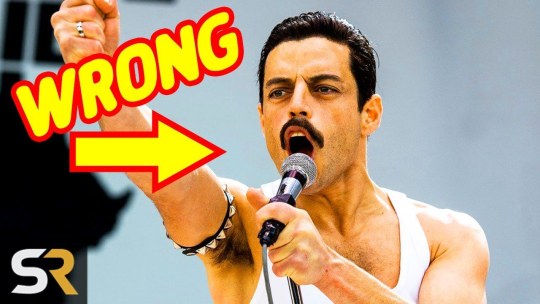
(To all my homies who know me, off course I was going to talk about Bohemian Rhapsody at some point. I’ll take that motherfucking cinematic slap in the face to the grave).
DAWN OF A NEW GAY ?
The question is simple : has visual media abandoned the dogma of La Cage Aux Folles ?
Harder answer. Yes and No.
NO, because if movies like Isn’t It Romantic (2019) in which a gay character is (even purposely) can be the protagonist’s cliché best friend still exist, it means that movies are still no over that phase of its education.
Also, if someone you barely know still ask you basic offensive questions about your sexuality, it means that we’re definitely still basically fucked. Remember, media is power.
And YES, in a way, this abominable dogma is long gone thanks to TV.
I know, right ? Cinema’s little bastard brother which didn’t want to talk about homosexuality in the 70s AND 80s ?
One of the first shows to depict homosexuality on a regular basis was HBO’s Oz. Thank you, cable. In between stabbings, sex violence and vicious murders, there was a serious exploration of the male sexuality.
Then came the 1998–1999 broadcast television season and its one-two punch. It followed Ellen’s Puppy episode (which we covered in the June 8th article).

On September 21st, 1998, Will & Grace premiered its first episode. And yes, today, we view it as a very narrow view on homosexuality. But think about it in the context of 1998. It’s a show with two of its leads unapologetically openly gay males (and a ageless woman ready to go either way). Each episode of the show was about homosexuality, and some jewish themes thanks to Grace, television’s number one fag hag. And shit, this show was funny until season 6. Like, real funny. Even the lost-in-time reboot has some redeeming qualities.
Finally, on February 17, 1999, the character of Jack introduced at the beginning of the second season of Dawson’s Creek, came out as gay. Don’t underestimate the power of teens. If they’re in on it, we all are. They were woke before “woke” was a thing.
That was just the beginning.

Queer as Folk (UK and US) and The L Word became pioneers of the LGBT TV revolution.
The Office’s Oscar Martinez came out in the season three premiere (2006), to limited clichés on its part.
Ugly Betty (2006–2010) was the gayest show of the 2010s.
By 2009, Glee ignored the window other shows created and busted the door wild open with at least 8 regular Queer characters. That same year, Modern Family introduced us to a very stable gay couple.
2011 saw the rise and consecration (in my mind) of Max Blum on Happy Endings, the ultimate cliché-avoider of the Queer community — so not a cliché that I identify more with his flaws as a man than as a gay man.
2012’s The New Normal failed at gaining the attention it deserved. Partners (2012) failed as well, but it kind of deserved it.
Brooklyn Nine Nine did something no one else did before : talk about bisexuality without making a big deal about it.
Buffy The Vampire Slayer, Once and Again, Six Feet Under, The Wire, Angels in America, Desperate Housewives, Battlestar Galactica, Grey’s Anatomy, Brothers & Sisters, Skins, Greek, True Blood, The Good Wife, United States of Tara, Shameless, American Horror Story, Please Like Me, Game of Thrones, Girls, Smash, Broad City, Orange is the New Black, Grace and Frankie, The Fosters, Superstore, Unbreakable Kimmy Schmidt, Orphan Black, Crazy Ex-Girlfriend, Transparent, Looking, The Real O’Neals, Friends From College, Sense8, One Day at a Time, This is Us, The OA, Champions, Dear White People, The Handmaid’s Tale, Pose, The Good Fight, Killing Eve, American Crime Story, The Haunting of Hill House, Now Apocalypse, Gentleman Jack, Years and Years.

They all, in small or big ways, contributed to what the situation is today.
Something closer to reality, debunked of clichés.
It’s a golden age to be Queer on TV.
I’ll say it a third and final time. MEDIA IS POWER.
A couple of years ago, I screened my end-of-study movie called Faggot (and Other Semantics) to my schoolmates and a few faculty members. The movie was about a gay dude trying to figure out who he was as a gay man (not a coming out but a coming in story) — it was very well received. At the end of the day, the tech guy who put the movie on signaled me to come and see him.
I did. He shook my hand and said ‘I didn’t know I could identify with a gay man but I did”. We’re talking about a straight single kinda annoying thirty year-old man. I wanted to slap him in the face. I kept thinking about what he told me thought.
I get it now. A window opened (even for a second) in his mind because a piece of Art took the time to represent someone “different” while using universal tropes. And without making fun of the situation.
It was an unwanted validation that I now fully accept.
That’s why La Cage Aux Folles is wrong and its dogma can fuck off.
Queer people have a voice now in the industry and are able to represent.
Queer people, REPRESENT.

0 notes
Text
6 Best Tamil Films From 2018 That You Must Watch!

Since the cinema came into existence, varieties of films have been coming out to the audience from the nook and corner of the globe. Indian cinema plays the biggest role in producing films and generating revenue from it. As we all know Indian cinema involves many other national as well as regional film industries which popularly include Hindi Cinema, Tamil, Telugu, Malayalam, Kannada, Marathi, Bhojpuri, Punjabi, and Assamese among others. Above all, Tamil cinema is an integral part of Indian cinema. It has been very content since its origins. Tamil cinema has produced many legendary directors, producers, cinematographers, editors, actors, actress, musicians, and writers and so on.
The year 2018 proved to very significant for the film industry as in this year films from art house cinema to mass cinema created a buzz in the country. On one hand, when films like “2.0,” made history by being one of the highest budget Indian film of all time, at the other hand, films like “To Let” created history by changing the course of the Tamil cinema by its content and representation.
Here, we will be discussing about six most important Tamil films of 2018 which can’t be left behind by a true cinephile. The list of these films is based on the writer’s own taste and understanding, however, your suggestion is welcome. Feel free to share your list of Tamil best films from 2018.
Pariyerum Perumal

This is one of the finest, genuine and intense movies I have watched in the year 2018. As said by K.R. Narayanan, “inherited caste system still remains with us”. The movie brilliantly portrayed the harsh reality of our society, about the ideologies of caste, inequality, life of oppressed people and honor Killings. It’s hard hitting and thought provoking. No hero build ups, no lengthy dialogues, no taking revenge, no blame games, everything is portrayed in a subtle way, carefully balanced from all the aspects.
The film boldly asks major questions revolving around the caste system and beautifully portrays a message for the same without ever sacrificing the story-line. Very depressing yet very eye opening movie brilliantly acted out by the majority of the cast, mainly by the protagonist Kathir, who played his role with ease and precision and aptly captured by Sridhar. Some of the songs bring out the emotions pointing to the evils of the rotten system. You feel exhilarated and empowered by the end of the movie.
Vada Chennai

Vada Chennai lives up to the expectation and hype it created since it was announced years back. The movie is raw yet so refined; the story telling is complex yet simple. The movie in itself has badness with goodness. It’s a perfect mix of things you never thought would sync together. The camera work and realistic feel is incredible. Very well edited and acted out by a talented cast, this movie which portrays a natural north Chennai slum not only is a masterpiece but also an eye candy for the viewers.
However, what works great for this movie is its attention to detailing, strong characterization, art direction, background score and the non-linear story telling that keeps us engaged and intrigued throughout the film. This film is directed by one of most promising young breed of Tamil film director called Vetrimaaran – who got name and fame by making one of the most radical, realistic, original and authentic film ‘Visaranai’ in 2015 which was India’s official entry for the Oscars. Vada Chennai is undoubtedly the finest work of Vetrimaaran.
Ratsasan

The opening frame of this film will remind you of the Korean classics ‘Memories of Murder and I saw the Devil’. It is one of most nerve wreaking thriller in a long time in Indian Cinema, you will be in the edge of the seat for the entire movie. You can’t even imagine that this movie was directed by the same guy who has directed Mundasupatti (a hard-core romantic drama). Such a strong story line and he has handled with ease. Each and every character in the movie has done a fabulous job.
The unpredictability is another major element that you will fall for while watching it. BGM was right there bringing you the much needed anticipation throughout the movie. Psycho thriller genre is not very successful in Tamil cinema as very few directors have explored this area. However, the director of the film Ram Kumar has definitely done justice to his work bringing us an ambient visual treatment. Climax of the films more intelligent, terrifying, and hypnotizing and the entire team made sure that there are no logical flaws or whatsoever in the movie.
96
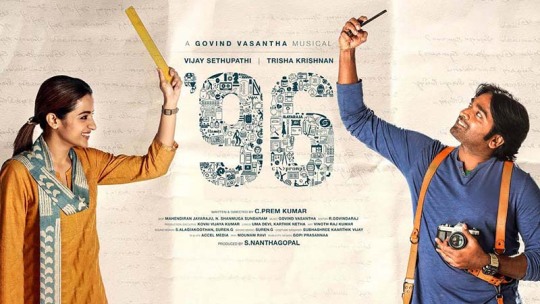
Love is an abstract word that no dictionary can define but its effect on humanity and life as such is astonishing. Some died, sacrificed themselves and some lived for it. This movie has brought out that beauty which made us realize that the word love is not just a few late night calls, letters and gifts; it’s all about giving a bit of you to another person. This film strokes all the right string of emotions with its artistic subtlety. The 90s, the dying years of the ‘simple life’ and perhaps the one snapshot in time that most people over 30 today would want to relive forms the premise of this story.
Each and every frame in the movie is admirable. Clear cut scene delivery. Sound effects are brilliant from the bird’s chirping when Ram and Janu are talking in the school campus to the rain sound when they are having conversation at Ram’s apartment, audience immersed into the film very easily. It’s a very simple yet hitting film which showcases how humans are trapped into social norms lose their own self in between. In some of the scenes you will get glimpses of ‘In the Mood For Love’. It has been executed flawlessly.
Merku Thodarchi Malai

‘Poetry in Motion’ describes this film in a completely pure way. Story of the film revolves around a group of landless workers living along the foothills of the Western Ghats in India. It depicts how the introduction of commercialization creates conflicts in the lives of villagers. There are very few Tamil films which has this level of cinematography. The camera simply goes from one place to another and you too as a viewer travel with the camera. Characters and locations look as natural as these could be. Legendary music composer, Illayaraja has composed the background Music of the film which makes the visuals look more appealing, engaging and impactful.
The film ends with a series of shots that show the helpful nature of humans who go beyond religion, caste, creed and region to help on another. In one scene, a Muslim man provides land to the hero without asking for money. In another, the heroine takes debt for the marriage of a girl who is not related to her. Tamil Superstar Vijay Sethupathi has produced the film under his banner and he should be appreciated for supporting such a radical and experimental film.
Mercury
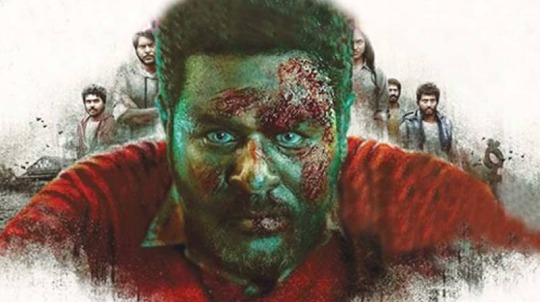
One of the most radical and new age film maker Karthik Subbaraj has already made a name of himself in the Indian film industry, especially in Tamil cinema with films like Pizza, Jigarthandha and Iraivi. Mercury is an addition into his filmography which clearly indicates the versatility of his film making style. Rommance, horror, reality and brutality are the elements that his films consist.
Mercury is undoubtedly another master piece from Subbaraj. It is a Silent movie and there is also a strong reason for the film being silent. You can understand that within five minutes of the movie. The story revolves around five people who are accidentally driven in to an old abandoned mercury factory and their attempts to escape from there. This film speaks about the environmental abuse by the corporate and also the emotional complexities of life. The cinematography, color tone and Background music is amazing. The film is described as silent but ends up being loud, noisy and disturbing.
The list and its sequencing are based on cinematic sensibilities of the writer. However, you are welcome to give your suggestion.
Read the full article
0 notes
Text
The spy and the movie guy
So, @leralynne inspired me to write some Minty to celebrate Season 5, and since I had this cute fic idea sitting around on my blog, I went for it. I present to you: International spy Miller and actually not his presumed informant Monty and Wednesday night movies. [also on ao3]
As far as informant meet-ups go, this one is pretty much by the book: Walk up to the informant as he stands in the agreed-upon spot, say the code-phrase and wait for the reply, then steer the conversation towards the intel – in this case, a flash drive with enough dirt to incriminate a bunch of people involved in a variety of illegal activities.
Sure, the meeting-place is a bit out there, perhaps – a ramshackle little movie theater that looks like it's been frozen in time in the 1950s. But while the flickering neon sign, threadbare red carpet and faded gold ornaments of the ARKADIA are unusually atmospheric for a simple informant meet-up, Miller decides he likes the place. It's got charm, and it reminds him of going to the long-closed Tivoli theater to watch old Westerns with his Dad.
It's also not a bad choice for a place to subtly make contact: Shortly before the start of the evening's feature films, the lobby is filling up with people, buying popcorn, meeting up with friends and looking at the posters and movie paraphernalia lining the walls. For a moment, Miller is surprised how busy the place is on a Wednesday evening, then he sees the posters advertising the weekday's reduced-price promotion. All the better, he thinks - no one will pay any attention to him when he steps up to the man currently standing in front of the poster for Hidden Figures, holding a gigantic bucket of popcorn and looking at his phone with a dismayed expression.
He sort of fits the description he sent he agency beforehand: Asian, late twenties, dark, floppy hair, regular to slim physique. (Although Miller wonders if that wasn't a bit too modest a description – the guy's wearing a short-sleeved shirt, and despite its loose fit, there's undeniable definition to his arms and chest.) Still, the description doesn't have to fit 100%, he knows – that's what the code-phrase is for after all.
Miller slowly makes his way over, taking a moment to study each poster until he's finally standing in front of his destination. The man hasn't moved, which only cements Miller's belief that he is in fact the contact he's looking for.
Picking up a leaflet with the theater's current program, he thumbs through it for a moment before he pretends to quote from it:
“Katherine Johnson knew: once you took the first step, anything was possible.”
The man looks around for a moment, trying to find out who Miller is talking to – which, alright, may be a little theatrical, but if it makes him feel safer about this endeavour, Miller won't make him feel bad about that. Then the man apparently decides that he's devoted enough time to the surprised act, and turns towards Miller to look at him – and startle him thoroughly with his beaming smile and happy exclamation:
“You read the book!“ When Kane sent him the code-phrase, Miller hadn't imagined hearing the informant's reply with quite so much enthusiasm – usually, these sort of meetings are quiet, subdued affairs where everyone is trying to draw as little attention as possible. But here, in this place that looks like it fell out of time, and on this guy who seems like he can probably muster up enthusiam for anything, it works somehow.
Miller nods, a little thrown by the impossibly bright smile directed at him.
“It's pretty good. I wanted to see if the movie can keep up.“
“Oh, it definitely can,“ the informant nods, still every bit as enthusiastic. “I've watched it three times already, and I bawled my eyes out every time.“
This is getting stranger by the second. Sure, the code-phrase was related to the movie, but usually, they'd have moved on from their original smoke screen of a topic to, well, exchanging the actual information. So Miller does something he doesn't usually have to do: He prods.
“So, you got anything for me?“
There's a note of confusion on the other man's face now, but after a moment's hesitation, he nods towards the giant bucket of popcorn he's holding.
“The popcorn's pretty good here. And I bought way too much because my asshole friend cancelled on me last-minute.“ Another hesitant beat, shorter this time. “We can share, if you like.
Miller suppresses a sigh. It happens sometimes: Informants get freaked out at the last minute. At least this one hasn't skipped out on him entirely. Now it seems Miller just has to calm him down enough to get that data.
“I would like that.” He smiles, warm and inviting, and can tell from the way the other man's eyes widen that the charm did its trick. The whole “seduce and confuse”-approach isn't normally his thing (that's Bellamy's specialty), but he can flirt his way into a target or informant's trust in a pinch. Still with his warmest smile in place, he holds out his hand. “My name's Miller, by the way. Nathan Miller.”
The informant smiles back and Miller notes absently that ignoring his grumpy and aloof nature in order to crank out some charm isn't as much of a chore as it usually is.
“Monty.”
The door to the auditorium next to them opens at this moment, the usher allowing in the first guests, and Monty steers determinedly towards him, supposedly to enjoy his fourth screening of the movie. Miller curses quietly at the thought of potentially wasting two entire hours on this simple assignment, no matter how good the movie, but follows him anyway. He has no choice if he wants that flash drive, but there's a tiny part of him that is also intrigued by this man, who seems fairly normal but then goes around endlessly rewatching movies so he can cry about them.
He is also, Miller realises five minutes into the movie, the kind of person who comments. A lot.
Which, under any other circumstance, would annoy the hell out of him, because Miller likes to watch his movies in stoic silence and then think about them alone afterwards. He does not need to analyze things as they happen on screen, or to hear little fun facts about the actors or the filming, or to hear other peoples' opinions on the movie before they've even finished watching. And yet, that's exactly what Monty provides – and Miller finds that he likes it.
Because Monty, it turns out, is funny as hell and smells very good, both of which Miller finds out when he first leans across the armrest to comment on soomething, and soon the flash drive is completely forgotten as he's nodding along with Monty's commentary and stifling inappropriate laughs and leaning in a little more each time Monty inclines his head towards him.
"I swear to God, if they don't give Taraji an Oscar for this, I will riot," Monty declares, then adds sheepishly: "On Twitter, at least."
Miller laughs softly, and when he looks at Monty, the light from the movie screen dimly illuminating his face, the other man is looking back at him, eyes wide and mouth parted slightly, and Miller knows what it means from countless hours of body language interpretation courses. He also has a pretty good feeling that he himself is looking much the same way right now. And Miller realises, right there in that darkened movie theater, that he's fucked. Not only has he now wasted almost two hours and is still no closer to getting that data, but, he realises, he's enjoying himself far too much. There's a pleasant little hum inside him every time Monty leans closer to share his thoughts on the movie; shoulder brushing against Miller's, warm breath rushing past his cheek, his low whisper vibrating through Miller's over-alert body, and Miller goes from “international super spy” to “teenager with a crush” within the span of less than two hours.
He's almost relieved when his phone lights up, minutes away from the end of the movie, and there’s a message from Kane to distract him from this torture.
SOURCE SAYS YOU NEVER MADE CONTACT. WHAT HAPPENED?!?
Shit.
Shit shit shit.
Monty isn't his source.
Monty is simply a chatty, funny, incredibly cute cinephile who has nothing better to do than befriend the other poor souls who are damned to go to the cinema alone.
And then, for the first time in possibly ever, Miller has an unprofessional thought as Kane's words fully register: If Monty isn't your source, a selfish little voice whispers in his head, that means you can see him again.
And so, when the movie ends, Miller doesn't rush off back to headquarters immediately, as he should. He turns to Monty as they're filing out of the theater and says:
"This was fun. Wanna do it again some time?"
Monty stops in the middle of the hallway, throwing the ordered exodus of moviegoers around them into disarray, to stare at Miller for a moment. Then that smile makes another appearance, just as startling as the first time.
"I'm here most weeks for the Wednesday special."
This time, Miller doesn't have to consciously bring himself to smile back – it happens all on its own. "See you next Wednesday then.”
Monty nods, looking a little overwhelmed, and Miller actually winks at him giddily before he remembers that he needs to go and lets the crowd sweep him towards the exit.
The lightness in his chest lasts all the way back to headquarters, and not even the prospect of having to explain his monumental fuck-up can ruin it.
He should definitely go to the movies more often, Miller decides.
The debrief goes over better than expected – Kane isn't exactly pleased, but Miller has never majorly messed up before, so he lets it slide. The only awkward moment comes when Bellamy asks:
“So if the man you thought was the informant didn't give you any intel, what the hell were you doing at that theater for two hours?”
Miller can only reply dumbly: “I watched the movie.”
Luckily, this is where Kane's passion for psychology saves him: Instead of reproaching Miller for not ditching the useless non-informant, Kane actually praises him for gaining his trust.
“Sometimes an informant isn't ready to get into the details right away. In such cases, building up a rapport is crucial.”
Bellamy huffs and Miller grins smugly and all but floats home that night. Against all odds, he got out of this fuck-up with nothing more than a mild reproach. Kane already managed to re-establish contact with their source and convinced him to try another pick-up. And in less than a week, he'll see Monty again.
Nathan Miller has snuck past Fort Knox-worthy security measures, jumped off cliffs, faced down armed assassins, and fought his way out of a whole bunch of seemingly impossible situations. And yet, he's never been more nervous than he is now, standing in front of the ARKADIA on a rainy Wednesday to see La La Land.
Monty is nowhere in sight, and for a short, stupid moment Miller thinks he forgot about their not really a date-thing. Or perhaps he decided to avoid the creepy dude who randomly quoted stuff at him and then followed him into the cinema to steal his popcorn?
But just as he's about to lose his nerve and leave, he spots a shock of dark hair, and then Monty is standing before him wearing jeans and a striped shirt and the same impossibly bright smile he wore last week.
“Hi!” He says breathlessly, then adds: “Sorry I'm late. My bike refused to cooperate.”
Miller wants to blurt out that he almost thought he wouldn't show at all and admit how fucking happy he is that he did, but then the usher calls out that their movie is about to begin, and they hasten inside.
The experience is exactly as great as the last time, quietly shared jokes and Miller's heartbeat speeding up every time Monty's shoulder bumps into his, and Miller knows with sudden clarity that he never wants to give this up again.
He's back next week for another Oscar nominee, and then the week after that, and of course they're catching Moonlight the week after the Oscars. But watching movies soon becomes secondary to just meeting Monty, and soon his favourite thing about Wednesdays is standing in the lobby after the screening to go over every little scene until they're asked to leave because the ARKADIA is closing for the night. Instead of ending the conversation there, Monty suggests they head to a nearby coffee shop, and with a cup of hot coffee in hand, it's easy to move on from the movie to other topics, some more related (favourite movies, books, musicians) some less. When the conversation eventually turns to their love lives and Monty mentions that he's bisexual, Miller can't stop smiling the next day at work.
Tonight, Monty is nursing his second double Americano in preparation for a night shift to update some company's IT system. Miller briefly considers helping him out with a caffeine pills, one of the many supplements available to him at the agency and strong enough to keep anyone up for days. But of course that would only raise questions, so he stays silent, sips his Cortado and listens as Monty animatedly explains that this upcoming job will be the most challenging thing he's ever done and he can't wait to get started.
Miller briefly considers telling Kane to look into recruiting Monty at the agency, where he could have a new challenge to freak out about every day. But he knows he won't, because a selfish little part of him knows that Monty is the only thing in his life that the agency doesn't have a say over and wants to keep it that way. Their Wednesday evenings; movies and too much popcorn and stories from life as a normal person with a flat share and a cubicle desk and a nagging Mom – these evenings are his, and his alone.
“I'm sorry, listen to me rambling. You probably just want to go home and sleep, and here I am raving about boring computer stuff.”
“No!” Miller replies, so quickly and ferociously Monty draws back a little. “I don't mind listening when you talk about your work. It sounds like you've got a really cool job ahead of you.”
Monty's already smiling again. “I really do. But I'm still going to stop talking about myself. I feel like we never talk about you.”
Miller swallows hard. Monty's not wrong, their conversations do revolve more around Monty than around him – but then, there's a reason for that. He can't share much about his life with Monty no matter how much he wants to – and boy, does he want to. He's come up with a cover story that isn't too far from reality and told Monty that he's a police officer, training to be on a swat team. It's a good choice, because it accounts for showing up with a black eye or talking about harsh training sessions, and he knows a little bit about it because of his Dad. It's not the same as talking about what his life is actually like, about the amount of government-sanctioned snooping and stealing and, yes, killing he's done so far in his short career. But it's better than not talking to Monty at all.
Monty seems to accept the story in any case, although his look of relief when Miller says he has nothing to do with cyber crime tells him he should definitely never mention Monty's name around Kane. And probably also find out a little bit more about his new buddy before he gets any more... attached. It wouldn't be the first time someone tried to get access to the agency by befriending or seducing one of its agents, and while Miller always thought that couldn't happen to his sarcastic, bristly, mistrustful self, that was before he met Monty.
The thing is, with his boundless enthusiasm and determination to have faith in the good in people, Monty brings an outlook on things into Miller's life that, after years of spying on people, has been almost completely lost. But Monty's no wide-eyed ingenue: He's astute and perceptive, and his moral judgment, when he can be persuaded to judge anyone or anything at all, is as harsh as it is absolute – and this too is refreshing, because in Miller's world, pragmatism is king, grey areas are his preferred place of action, and too often he has to make choices expecting to ask for forgiveness rather than permission.
Still, it takes a long time for Miller to finally admit to himself just how hard he has fallen for his accidental friend. But then a mission goes sideways, a bullet slips past the edge of his kevlar vest and buries itself in his side – and all Miller can think is that it's Tuesday and getting shot most likely means he'll miss movie night.
Then he blacks out.
It takes over a week until Miller is awake and lucid and strong enough to make a phone call from the hospital phone. Luckily, he still knows Monty's number by heart, because he never saved it in his phone and only ever contacted him from various burner cells to make sure Monty can't be easily traced back to him – a safety precaution he hates but that comes in handy now, seeing as his phone is trashed beyond repair.
When Monty picks up the phone and says his name, Miller's throat tightens for a moment because he's so happy to hear him – and so scared Monty won't want to talk to him, given that he bailed on their last movie night without so much as an explanatory text.
“Hello? Who is this?”
“I'm sorry I stood you up,” Miller blurts out.
“Nate?”
“Yeah.”
“I didn't think I'd hear from you again, after you stood me up and didn't even text. Twice.”
This is the part where he needs to explain, Miller knows – but instead, his mind gets caught on that last little word.
“Twice?”
There's a moment of silence at the other end of the line, then the sheepish response: “I returned the week after that. I thought maybe you'd show up and explain... I'm a hopeless rom... optimist like that, I guess.”
Miller's heart skips. Did Monty just almost call himself a “hopeless romantic”, thus implying he thinks of them in romantic terms?
God he hopes so. And decides, then and there, that if Monty forgives him, he's going to make one hell of a big romantic gesture as soon as he gets out of this hospital.
“I can explain now.”
“You don't have to. It's your time, you can spend it however you like, with or without me.”
“I'm at the hospital, Monty.” Miller says bluntly, suddenly impatient. He needs Monty to understand, which means he needs to explain. “I got shot.” And then because that feels like it might raise a lot of questions and because he just remembers his very convenient fake backstory, he quickly adds: “While I was on patrol.”
“Shit, Nate, I had no idea! I'm sorry I gave you flak for standing me up...”
Miller laughs softly, then stifles it immediately when pain twinges through his chest.
“You couldn't know. For all intents and purposes, it looked like I stood you up, and I'm sorry.”
But Monty won't be appeased. “No, you don't understand! You know how when you get stood up, your friends try to cheer you up with all these wild explanations?”
Miller doesn't, really, but then Murphy and Bellamy are hardly the kinds of friends he confides in about his love life.
“Well, my friend Clarke tried to do that when I told her, she suggested that maybe you were caught in a shootout, and I....” he breaks off, strangled, then continues with an anguished voice: “I actually said “he better be”! I'm a horrible person, Nate!”
Now Miller can no longer hold back a fond laugh, chest pain be damned. But he's filled with such warmth and affection for this man who came out of nowhere and is the definition of that silly “precious cinnamon roll”-meme and made his life 1000 per cent better.
“You're not a horrible person, Monty. You were hurt, I get it. And it's not your fault I got shot. Things went South, it happens. I'm recovering now, okay? They moved me out of the ICU into a regular ward and everything. Just...” He swallows, suddenly nervous. “Just don't watch Guardians of the Galaxy 2 without me, please?”
“Are you kidding? That won't be released for another month! I'm not waiting that long!” There's a brief pause, and Miller wonders hopefully if it's due to nerves on the other end as well. “Which hospital are you in? I'm stopping by as soon as I'm finished here.”
Heart feeling like it's about to burst, Miller gives him the name and address of the hospital, and Monty promises to swing by as soon as possible. Which means two things: He's going to see Monty again soon. And he's going to need a shower and some clothes that aren't hospital-issued, and pronto.
Unfortunately, by the time he's achieved that, there's still no sign of Monty, and Miller already feels exhausted again, an unfortunate side effect of recovering from a bullet wound. No matter how much he fights it, soon his body succumbs to the tiredness, and he nods off.
When he wakes up, Miller wonders for a moment if he died in that shooting after all.
For one thing, his room smells like popcorn. For another, there's a giant Marvel logo hovering in mid-air before him, and it takes him a startled moment to work out that it's actually projected onto the wall. The projector in question is set up on one of those tall hospital bedside tables. And next to it, clicking around on the laptop attached to the projector, is Monty.
“Hi,” Miller croaks, and Monty looks up and almost drops his laptop in his haste to set it down and rush over to the bed.
“Hi! How are you feeling?”
“Pretty good, I guess?” Honestly, right now he's mostly very confused. “What's going on here?”
“Well, I figured since you missed our last two movie nights, we could just catch up here.”
Well, clearly, Monty beat him to his big romantic gesture.
“How the hell did you get the nurses to let you do this?”
Monty shrugs, but there's a hint of pink appearing on his cheeks that disproves the attempt at casualness. “I may have told them a bit of a sob story.”
Miller grins – knowing Monty, this is going to be good. “Oh yeah? What did you tell them?”
“Well, I told them you're my boyfriend and that it's our one year anniversary and we were planning to celebrate it at the cinema where we had our first date, but with you getting shot and all...” He blurts it out all in one rush, then shrugs again. “They were all very moved.”
Miller would laugh because honestly, with that talent for lying, Monty would probably fit right in at the agency. But Monty isn't laughing right now – instead, he's suddenly looking very nervous.
“I hope that doesn't bother you.” He swallows visibly. “It's a little hard to imagine, you and... well, me.”
The vulnerability on his face makes Miller feel like his chest is bursting, and he's relatively sure it's not because of the gunshot wound. Before he knows what he's doing, he's taken Monty's hand and pulled him closer.
“I don't think it is.” Monty's eyes widen, and Miller loosens his grip on his hand, but only enough so that he can softly trace the lines on his palm. He shrugs, then wonders if his nervousness is as apparent as Monty's was just now. “In fact, I like the idea.”
“You do?”
“Yes. Because I like you. And I like watching movies with you, and as soon as I'm out of here I want to do that again but as a date, and....”
He doesn't get any further, because suddenly Monty is kissing him and Miller has no idea what he was even going to say anymore. He tastes like caramel popcorn and minty chapstick and he feels like the best thing that ever happened to him or, for that matter, earth in general. It's only when he rises up from the bed, chasing Monty's lips a little too eagerly, that pain shoots through his chest and reminds him where he is and why heatedly making out may not be the best idea just now.
But then, there's always time for that later, after they've watched the movie and he's recovered some more.
“So, what movie did you bring?”
Monty presses play on his laptop, then promptly clambers back onto the bed as the movie starts playing.
“The first Guardians of the Galaxy, obviously.”
Miller makes an appreciative noise and burrows into Monty's side, a little overwhelmed by the fact that this is now something he's allowed to do. He no longer needs shoulder bumps and almost-touches across an armrest to sustain him – he can just snuggle right on up to Monty.
Monty himself is unusually quiet for once, perhaps a little overwhelmed by all the developments as well, and it gives Miller time to think. Finally, his brain zeroes in on one particular puzzle.
“You know what still baffles me?”
Monty transfers his attention from the screen to Miller and waits for him to explain.
“A stranger walks up to you, starts randomly quoting a book and then demands that you give him some of your popcorn. Why did you not get the hell out of there immediately?“
Monty smiles, and the faint trace of red on his cheeks flares up once more, to Miller's delight.
“The way I remember it, a super hot stranger walked up to me, hit me with the best pick-up line I ever heard, and then wanted to share my popcorn. I thought I was dreaming at first.“
Miller feels his own cheeks heat up a little as well.
“The best pick-up line you ever heard?”
Monty nods earnestly, and Miller has to admit, he has a point. Beside him, Monty grins.
”And I mean, it worked for you.“
“Yeah,” Miller agrees and leans in for another soft kiss, just because he can. Some day soon, he's going to have to explain to Monty what was really behind that pick-up line – but not just yet. “Thank God it did.”
#minty#minty ff#minty fanfiction#this was such fun#also their taste in movies is all over the place idec#my writing
37 notes
·
View notes
Text
Project 3 Final + Semester review







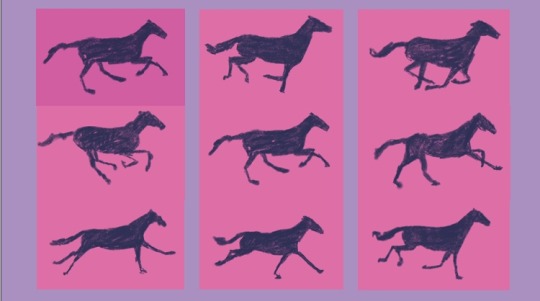
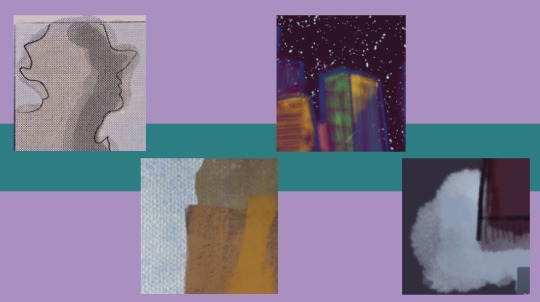
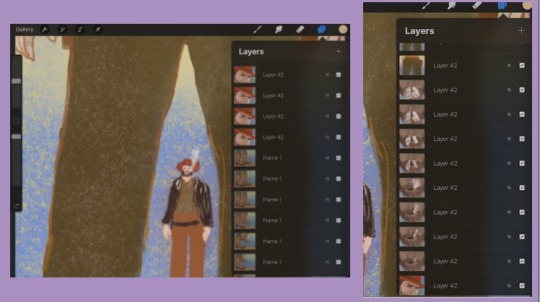

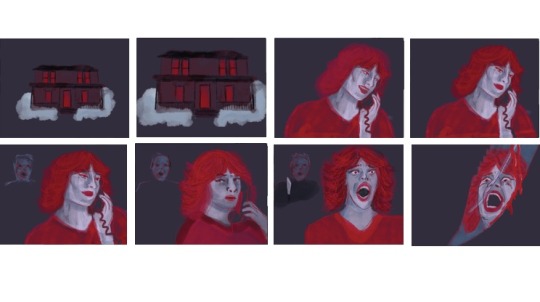
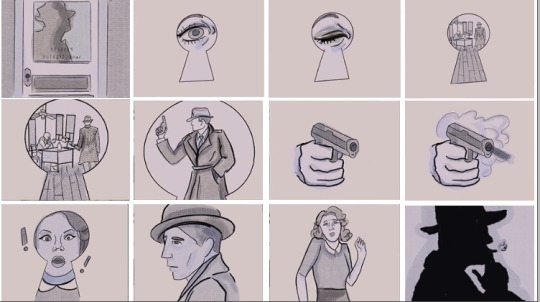


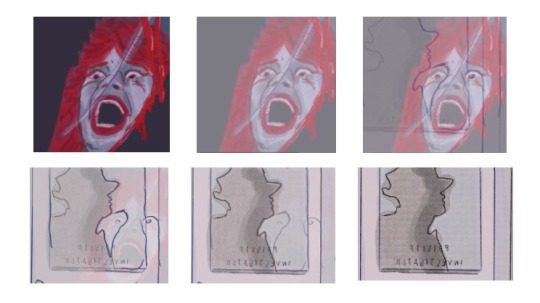




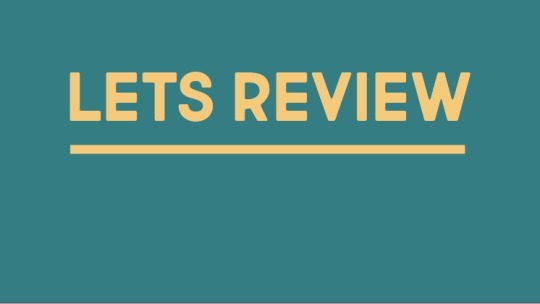
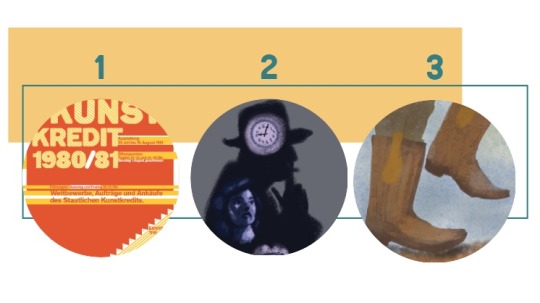


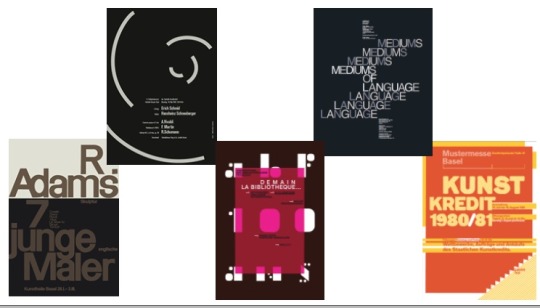


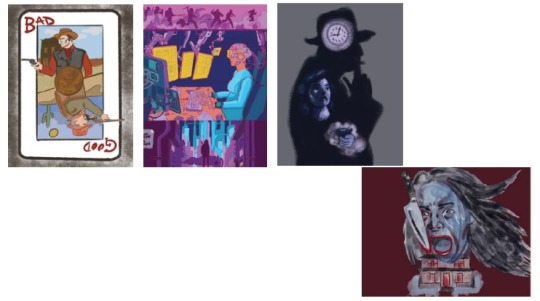

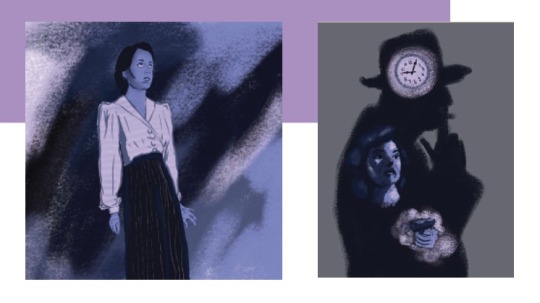


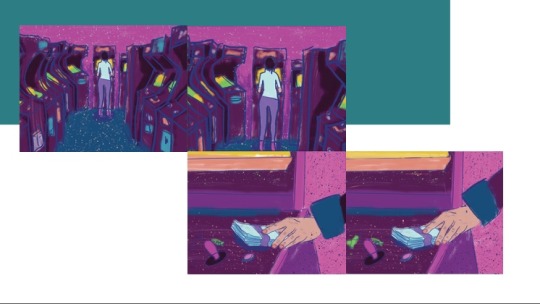



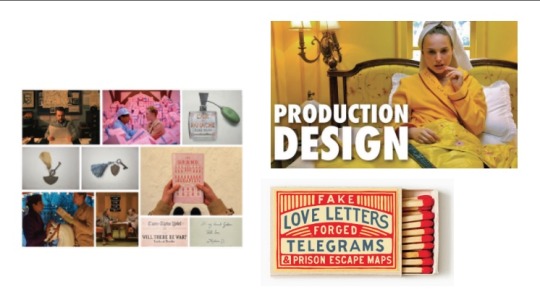



vimeo
521 Project 3 presentation script:
1.) Hello, and welcome to my presentation on Project three of ArtGr 521. For this project I choose to explore animation with a focus on narrative storytelling in frame by frame animation.
2.) As I covered in my last presentation I decided to change up my last two projects, adding in a project on illustration, removing a project on java, and moving the animation project to last.
3.) In my initial research on animation I found myself really drawn to animations with a handmade, more tactile feel, especially college base stop motion. With this in mind, I wanted to avoid the flat animation style that is very popular right now.
4.) I decided to continue the theme of the last project and work within the genres of western, horror, noir, and sci fi. I began with these assets, imaging a cowboy walking through a desert and into an old west town.
5.) However, the figure proved to nearly impossible to work with in AfterEffects, so I redesigned it in Illustrator to be more simplified and with distinct pieces that could be easily moved in AfterEffects.
6.) The results were…underwhelming, and I was having a really hard time achieving the look and style I was looking for. So I went back to the drawing board and tried to do more research, and what I found is that AfterEffects is great for creating motion graphics but not as great for more naturalistic animation.
7.) In my research I noticed that a lot of the animations I connected with were made using frame by frame animations in either Procreate or Photoshop. So, I thought I would give it a try to see if this was feasible and was pleasantly surprised.
8.) This style was not only much more comfortable for me and moved significantly fasted than using puppet pins in AfterEffect, but also allowed me to experiment more with mark making and texture.
9.) This freedom was the real draw for me, that I could not only mimic mixed media or traditional media animation, but also consider how those colors, textures, and layers can add to the storytelling and support the communication of a message.
10.) While frame and frame can sound daunting, I found working with all these frames actually helped me understand where you can simplify and economize, that the eye fills in a lot of information for you.
11.) I started my animations with what I called a framework but was essentially a shot by shot storyboards with line work only. This helped me layout what I wanted to show and how I would get from one frame to the next.
12.) Once I had animated all my frameworks I went in and added color, texture, and backgrounds. The horror animation was the last one completed but is first in my sequence. I was probably the least happy with this one but I’ll cover that later in the presentation.
13.) For my noir animation I was able to work off of a storyboard I had created during project 2 but choose not to move forward with. This was helpful given the short timeline to complete these animations.
14.) For sci fi, I had a clear idea of what I wanted for my storyboad, but I struggled to create the depth in each frame that I wanted. And while I like the finished project, I realized at the end my palette was a little too pink focused, which worked in the illustration but was a little overwhelming in the animation.
15.) The western animation was the first one I completed, and while because of that it is a little herky jercky in spots, I actually find it to be my favorite because I took more time to play around with details, making more nuanced in spots that the others.
16.) I knew I wanted to compile all of these animations into one video, but I wanted the transition between the videos to feel purposeful and not just cut to the next. So I went in and animated short transitions to tie the first and last frames together creating a less harsh transition.
17.) There are of course lots of things I would change given more time. The horror animation especially has some odd frames where a layer was accidentally deleted, or where the face doesn’t move as smoothly as it should. By the time I was animating this one it was crunch time and I just need to finish.
18.) I also can see that textures and marks got sloppier and less thoughtful the further along I went. The top two here are great examples of using marks in interesting ways to create a feeling, where the bottom two really missed the mark.
19.) I do feel like I learned a lot on this project, even with some rocky starts, and would really like to continue working on animations, exploring more tactile mediums like collage and stop motion, as well as giving Aftereffects and motion graphics a second chance.
20.) Overall, despite a few bumps, I feel like I learned a lot that I can implement in future projects and I think I’ll continue working with animation and pushing what I can do further as a gain comfort with the medium.
21.) I’ve uploaded the full final animation as a separate video, but I would so appreciate if you could watch it and provide feedback. So now that we’ve covered the basics of Project 3, let’s turn our attention to an overview of the semester as a whole.
22.)At the beginning of the semester I presented 3 projects, all of which I felt doable and little concern over, However reality set in fast and I found that the best laid plans oft go ary. Despite this I feel I still managed projects that pushed me and allowed me to explore arenas I am interested in.
23.) My research at the beginning of the semester was focused on Typography, a mix of illustration and animation, and generative art through coding. In the end the only topic that got the boot was generative art, which I’ve been exploring in another class, so the changes weren’t seismic.
24.) Despite changes to projects and unexpected hiccups along the way, I did try to maintain structure and timeframes, which not only helped me finish the projects and stay on time, but I think have helped me develop better independent work and project management skill.
25.) My exploration of Type in Project 1, lead me to reframing my initial goals, of become proficient in type, to more manageable ones of understanding how good typographic structure is designed and typeface identification.
26.) While this project didn’t yield elegant results to put in a portfolio I think it actually did something more for me, which was get me to think about type critically. What makes good typography? How do you think of type as system? As a structure?
27.) Was this project successful? I think so, I completed the goal – to create master copies of famous posters, and in completing that goal was able to gain a greater understanding of type than I had from several weeks of reading about type and blindly testing ideas.
28.) For Project 2, I chose to dive into a topic I feel a lot of affection for, illustration. I think this passion for the topic made the work that went with it easier, I enjoy drawing and painting which in many ways’ illustration is an extension of.
29.) this project gave me a chance to sit down and think critically about illustration, not just what I like about it, but why I like that and what is the intent of the artist. It gave me to time to consider how we use imagery to communicate, and where you can push those boundaries of communication
30.) With all of these projects time was an issue, given more time or at least more dedicated time would I have changed things, given more though to details and really honed these images, of course! But just like in the real world, there are deadlines you need to meet, so I feel pretty satisfied with the results.
31.) My project was focused on animation and narrative storytelling. I continued my genre exploration framing from project 2 and chose to work with a frame by frame style of workflow.
32.) I enjoyed working on these animations, it was a struggle, but each discovery felt like an “aha!” moment. It also allowed my to pursue ideas from project 2 that didn’t translate as well into a still image, looking at camera movements and cinematography.
33.) This project felt rushed, I can’t lie, I had some personal things going on that set me behind and I feel like I never really caught up. My biggest regret is that I was so rushed to finish this that I didn’t have adequate time to experiment, to try alternative and to explore abstraction.
34.) So now that we’ve reached the end of the semester, with all that I’ve learned and explored, and gained …. What’s Next?
35.) As implied earlier in this presentation, I’m not done with animation. I feel like I’ve just touched the tip of the iceberg and I now I really want to take some time to explore more experimental animation, to take things in a more playful, personal direction.
36.) I’m also looking to work more on taking what I’ve learned and applying it to less traditional means. I’m hoping to explore tactile and kinetic type, and thinking of ways to merge type and imagery. I’m also interested in exploring the interaction of design with fields like art, cinema, and theatre more.
37.) With this intersection in mind, I’ve been exploring production design in my limited free time, and it’s something I want to dive further into, as I think this concept of creating a world not just a product could lead to some interesting design work.
38.) While working though this semester I’ve been trying to keep my thesis, which is exploring de stigmatizing death and grieving, in mind and I was kindly sent an article that discussing how designers and illustrators are already looking at this issue.
39.) I think I’ll definitely be pulling from concepts explored this semester I look to understand how to approach difficult conversations in a non-threatening and participatory way.
40.) Thank you for your time. I look forward to reading your comments and question.
1 note
·
View note